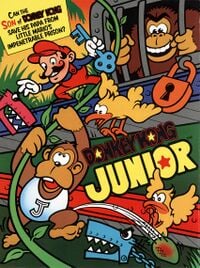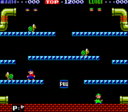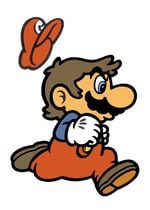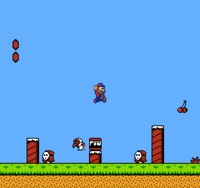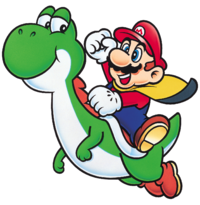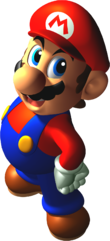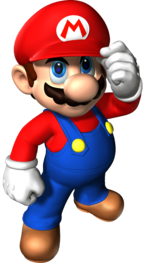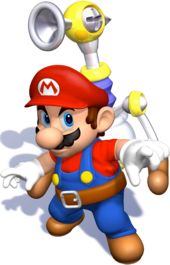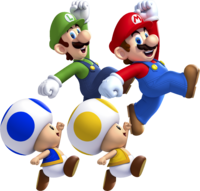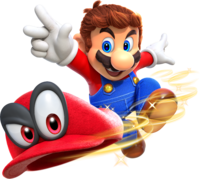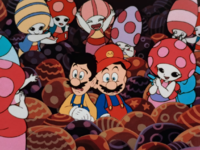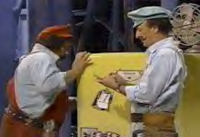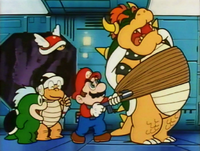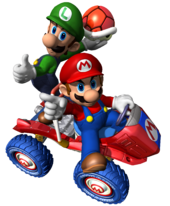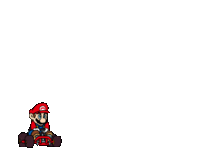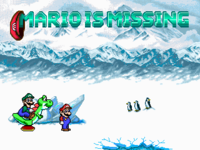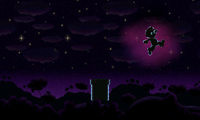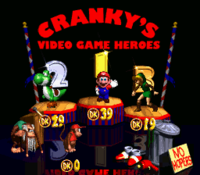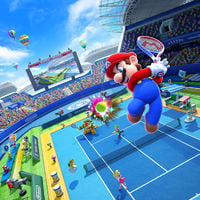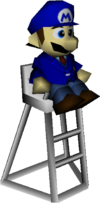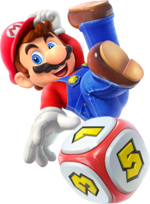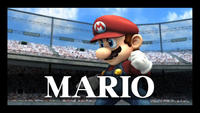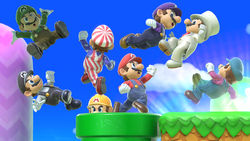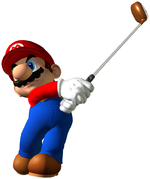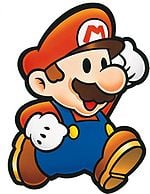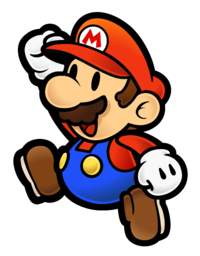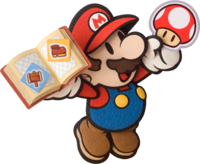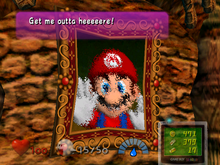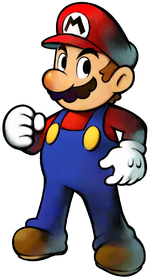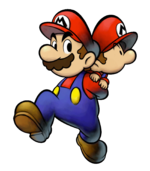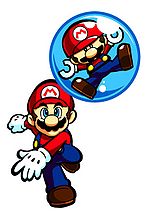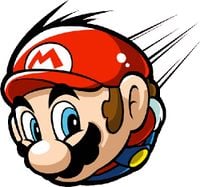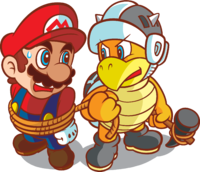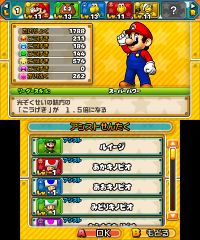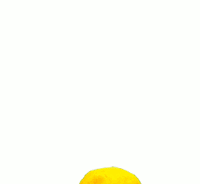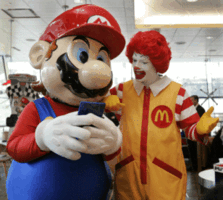History of Mario: Difference between revisions
m (→Alleyway) |
|||
| Line 262: | Line 262: | ||
In ''[[Alleyway]]'', similar to ''{{wp|Breakout (video game)|Breakout}}'', Mario controls a paddle that deflects a ball to break a particular formation of bricks. During bonus rounds, various brick formations resembling sprites from ''Super Mario Bros.'', including Mario's sprite, are shown. | In ''[[Alleyway]]'', similar to ''{{wp|Breakout (video game)|Breakout}}'', Mario controls a paddle that deflects a ball to break a particular formation of bricks. During bonus rounds, various brick formations resembling sprites from ''Super Mario Bros.'', including Mario's sprite, are shown. | ||
==''NES Open Tournament Golf''== | |||
In ''[[NES Open Tournament Golf]]'', taking place on [[Earth]], Mario retains his blue shirt and red-and-white striped overalls. Princess Peach is depicted as Mario's caddy, who helps carry Mario's golf equipment. | In ''[[NES Open Tournament Golf]]'', taking place on [[Earth]], Mario retains his blue shirt and red-and-white striped overalls. Princess Peach is depicted as Mario's caddy, who helps carry Mario's golf equipment. | ||
Revision as of 00:21, May 20, 2023
It has been requested that this article be rewritten. Reason: the article has too many extensively written plots; we need only a paragraph or three of a summary of Mario's role, and plot details should link to the main article
- Main article: Mario
As Mario is a recurring main protagonist of a large and major video gaming franchise, his history spans decades of media primarily in video games, but it also includes cartoons, books, and miscellaneous promotional materials.
Background
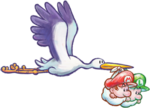
Super Mario World 2: Yoshi's Island depicts Mario's beginnings by delivery of a stork at nearly the same time as Luigi, suggesting a twin birth. Super Mario World 2: Yoshi's Island is usually considered as one of the first media chronologically in Mario's history, but a few other sources, usually older than Super Mario World 2: Yoshi's Island, depict different beginnings. In Super Mario Momotarō, for instance, two elderly Hammer Brothers have found and raised Mario, who emerged out of a peach that has fallen from the sky. Mario here resembles his older self, although smaller and without a cap. The story in Super Mario Momotarō, however, is a retelling of a popular Japanese fairy tale and may have no actual bearing on Mario's history. The Nintendo Comics System comic entitled "Family Album "The Early Years"" is another early medium that depicts Mario's childhood. According to it, Mario has taken an early interest in plumbing, although frequently misbehaving, such as making his father's pipe emit bubbles instead of smoke. Mario is also adept at sports, scoring home runs in his neighborhood softball team. Mario at birth is shown to have full hair on the head and facial stubble that quickly became a mustache. The comic also depicts Luigi as several years younger than Mario, whereas he is depicted as Mario's younger twin in the video games. The Super Mario Bros. Movie is a later portrayal of Mario's childhood from Brooklyn. Family portraits and dialogue indicate that they attended high school and graduated. From Mario and Luigi's room, Mario's hobbies include playing sports, playing retro video games, and collecting retro video game memorabilia. Before working as plumbers, Mario and Luigi worked in a construction company with Spike as their boss.
Donkey Kong series
Donkey Kong

In Donkey Kong, Mario is a carpenter who needs to rescue his girlfriend, Lady, from Donkey Kong at a construction site. Mario can jump over obstacles such as the barrels Donkey Kong throws, or Mario can use hammers to destroy the barrels and defeat other enemies. After defeating Donkey Kong in the final level, Mario is reunited with Lady.
In the Game & Watch version of Donkey Kong, the objective is the same as in the arcade version, but Mario must trigger a lever, which causes a hook to appear. If Mario grabs the hook, a peg is removed and he is transported to the starting point. If Mario misses, he falls and loses a life. If Mario removes all the pegs, he defeats Donkey Kong.
Donkey Kong Jr.
In Donkey Kong Jr., Mario appears as the antagonist, having captured Donkey Kong and holding him in a cage, with the protagonist of the game being Donkey Kong's son, Donkey Kong Jr. As Donkey Kong Jr. moves through the levels, Mario sends out enemies like Snapjaws, Nitpickers, and other obstacles to stop him. After Donkey Kong Jr. rescues Donkey Kong in the final level, Mario falls and is defeated. In the arcade version, Mario regains consciousness and attempts to pursue the pair, only to be sent running away by a kick by the elder Donkey Kong.
During the intro to the arcade version of the game, there are two Marios that are seen carrying Donkey Kong away.
Donkey Kong II
Since Donkey Kong II serves as a semi-sequel to the Game & Watch Donkey Kong Jr., Mario reprises his role as the antagonist.
Donkey Kong Circus
Mario appears as the antagonist in Donkey Kong Circus. Mario is an audience member who laughs at Donkey Kong whenever he drops a pineapple or grabs a fireball by mistake. The Circus seems to be at the construction site where the first game begins, based on the girder-like platform Mario stands on.
Donkey Kong Hockey
Mario appears in the game Donkey Kong Hockey as the protagonist. His hockey shot is less powerful than Donkey Kong's, but it has more range.[citation needed]
Donkey Kong (Game Boy)
Mario makes a later appearance in the Donkey Kong series with a new appearance in Donkey Kong for the Game Boy. Along with the original four Donkey Kong levels, Mario has to travel through an additional nine worlds to rescue Pauline. Mario can also perform additional acrobatic maneuvers that can assist him in navigating through levels.
Mario can perform a handstand move, which protects him from any objects falling on him from above. From the handstand position, Mario can also perform the Handstand Jump. The game also features the backflip as well as wires on which Mario can wire-spin and jump to catapult himself high in the air. Another essential part of Mario's moveset, taken from Super Mario Bros. 2, is his ability to pick up enemies and objects and lift them over his head to throw them. This is also one of the few Mario games in which Mario takes damage and can lose a life from a high fall.
In most stages, Mario has to find the key and take it to the locked door in order to proceed to the next level. As long as Mario holds the key, he has an additional hit point, although he loses the key when he takes damage. He uses hammers as seen in the original Donkey Kong and constructs temporary ladders and roads in order to pass through the levels. Other levels are boss fights against Donkey Kong Jr. and Donkey Kong. In the final level, Mario must navigate through the level while chasing Donkey Kong and Donkey Kong Jr. to the top of the tower, where he eventually traps Donkey Kong Jr. in a cage, defeats a giant Donkey Kong, and rescues Pauline. In the game's credits, however, Mario seems to have reconciled with Donkey Kong since they are shown together with Donkey Kong Jr. and Pauline in a photo in Rocky-Valley.
The ending of the game shows Mario holding Donkey Kong above his head (with Donkey Kong yelling, "HELP!") as Donkey Kong Jr. is standing to the left of him. To the right is what appears to be the start of World 1-1 from Super Mario Bros. This foreshadows the events of both Donkey Kong Jr. and Super Mario Bros.
Donkey Kong (coloring/activity books)
In a series of activity books from 1982–1983, little Mario the carpenter appears as a hapless, balding, middle-aged employee at Video Land Amusement Park. He is in love with the much younger Pauline, but is unable to express it. He sets off to rescue Pauline after Donkey Kong breaks free from his cage and kidnaps her.
Game & Watch series
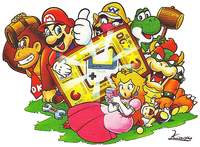
Mario has appeared in several Game & Watch games, including Mario Bros., Mario's Cement Factory, Mario's Bombs Away, Super Mario Bros., and Mario the Juggler. He also appeared in four installments of remakes marketed as the Game & Watch Gallery series, and he later appeared in Game & Watch Collection.
In Mario Bros. (which is unrelated to the arcade game of the same name), Mario and the newly introduced Luigi must cooperate and put pallets of bottles on a delivery truck. They have to use conveyor belts to send the package to each other. If they drop a pallet, their boss yells at them. If they drop three pallets, the game is over. In Game & Watch Gallery 3 and in Game & Watch Gallery 4, Wario is the boss and Bowser periodically reverses the conveyor belt directions. Cakes replace pallets in the game.
In Mario's Cement Factory, Mario must move cement from hoppers into cement trucks by putting them on conveyor belts. The hoppers can hold only three loads of cement. If a hopper overflows, some cement can land on a worker, making Mario lose a life. Mario can move by using an elevator, but if he moves when the elevator is not there, he falls and loses a life. If Mario stays in the elevator for too long, he can be crushed or can touch the very bottom, losing a life either way; there are safe zones to circumvent this. In the remake in Game & Watch Gallery 4, Yoshi and Toad appear as background characters. A Boo can appear and interfere with the work. Mario can fall from the elevator, but when he touches the bottom ground, he gets a miss.
Mario must safely deliver bombs in Mario's Bombs Away, avoiding oil spills and torches.
Super Mario Bros. for the Game & Watch plays similarly to the original game for the NES. This version, however, is simpler and shorter.
Mario is featured in Mario the Juggler, a Game & Watch game based on the very first one, Ball.
In the Modern games of Game & Watch Gallery remakes, Mario also takes some roles previously taken by other characters. Other times, he is a non-playable character. In Fire, for instance, he and Luigi rescue Toads, Yoshis, and Donkey Kong Jrs. from a fire. In another example, in Chef, Peach must cooperate with Mario and Luigi to feed Yoshi. Mario and Luigi throw the food, and Peach can catch it in her pan.
Mario Bros. series
After Donkey Kong Jr., Mario's next arcade appearance is Mario Bros. in 1983. Only Mario's physical appearance is taken from earlier titles; Mario is now a plumber in the sewers of New York[1][2] (his house according to Atari[3]) and fights an endless number of creatures, such as Shellcreepers and Sidesteppers. Unlike in later games, Mario cannot jump on enemies. Instead, he must jump against the ceiling of a platform from below to stun all enemies walking on top of it. When Mario approaches the stunned enemies, he kicks them out of the screen, rendering them defeated. In the two-player mode, the second player plays as Luigi, here portrayed as a green palette swap of Mario.
The brothers reprise their role in two Japan-only sequels for home computers, Mario Bros. Special and Punch Ball Mario Bros. In Mario Bros. Special, Mario has to stun enemies by jumping on shared trampolines before dispatching them. In Punch Ball Mario Bros., he needs to hit them with a Punch Ball first.
Mario shoots at Koopas and various other enemies in Mario Clash, a game for the Virtual Boy. Mario has to knock enemies away with Koopa Shells at the side. The game's gameplay is similar to the style of Mario Bros., but Luigi is absent.
Saturday Supercade
Mario appears as a regular character in the Donkey Kong segments of Saturday Supercade, which was his first appearance in a television show. In the show, he was an apparent circus owner along with Pauline who worked as an animal trainer. Donkey Kong escapes from the circus and Mario and Pauline are always on the loose to capture him. They go through many adventures where Donkey Kong gets himself involved in many situations and Mario and Pauline try to help make things right.
Golf
The first time Mario appeared in any sports game was in Golf where his proportions are more realistic. In Japanese versions of Golf, Captain Rainbow would later identify the character as a more generic Ossan (although this was one of Mario's initial names during development of Donkey Kong).
Family BASIC
The Family BASIC is an accessory to the Family Computer that lets users program their own games. Mario is one of the available sprites. In Family BASIC V3, he appears in two mini-games, one of which he is a controllable character.
Wrecking Crew series
VS. Wrecking Crew / Wrecking Crew
In VS. Wrecking Crew, an arcade game for the VS. System, Mario and Luigi are workers on a demolition site. Mario must break all the walls before enemies can stop him. In this game, Mario wears a helmet, shoes, and dark-red overalls. Unlike the NES version, this game has a simultaneous two-player mode, where Mario and Luigi can compete or cooperate. In single-player mode, Luigi is an opponent that attacks Mario, but Mario can hit him with his hammer and cause him to fall. They use hammers similar to those previously seen in Donkey Kong against Gotchawrenches or each other. If Mario stays too long, a fireball appears to hinder his progress.
In the NES game Wrecking Crew, Mario faces off against Foreman Spike instead of Luigi. Mario can now defeat enemies by trapping them in drums. Mario can also wield the Golden Hammer, which can smash any wall with a single swing.
Unlike their Japan-only sequel, Wrecking Crew '98, these games have no specific plot.
Wrecking Crew '98
In Wrecking Crew '98, Mario finds the Mushroom Kingdom covered with Bowser's new high-rises. Foreman Spike also makes a reappearance, along with several other enemies from Wrecking Crew, this time helping Bowser. These buildings negatively impact the Mushroom Kingdom's environment, so Mario must demolish these structures.
Unlike in the earlier games, Mario can hinder his opponent's progress by raining panels on them. To clear the stage, Mario must demolish blocks or arrange three consecutive panels vertically or horizontally. If four or more panels are aligned, Mario can rain panels onto his opponent. If he clears the field, he receives a Mushroom, boosting his offensive combos toward his enemy.
Super Mario series
Super Mario Bros.
In Super Mario Bros., Mario arrives in the Mushroom Kingdom, where his objective is to rescue Princess Toadstool from Bowser. Mario can gain power-ups and coins from jumping against ? Blocks and Brick Blocks. Mario begins the game as Small Mario, who loses a life from any enemy attack. By using Super Mushrooms, Mario grows into Super Mario, who has an additional hit point (reverting to Small Mario after being hit). Super Mario has access to the Fire Flower, which lets him throw fireballs that can knock out enemies. Mario can also become invincible for a short amount of time with the Starman.
Super Mario Bros.: The Lost Levels
Mario appears in Super Mario Bros.: The Lost Levels, the sequel of Super Mario Bros., with the same role as in the original game. Mario's traction and jumping height remain the same, while those of Luigi are changed to differentiate him more from Mario. Luigi jumps higher than Mario but has less traction. This would be a distinguishing feature used in future games.
Super Mario Bros. 2 / Super Mario Advance
In Super Mario Bros. 2 and its reissue, Super Mario Advance, Mario is a well-balanced character with no special abilities. The gameplay of the two games is different from other Mario titles: Enemies can no longer be defeated by stomping them, and Mario gains the power to pick up enemies, lift them over his head, and throw them.
In the story, based on the Japanese game Yume Kōjō: Doki Doki Panic, Mario has experienced a dream one night. The fairylike beings from the land of Subcon inform him that Wart has taken over the land of Subcon and that they need Mario's help to defeat Wart. After awakening from his dream, however, Mario dismisses the dream and returns to sleep. The next day, Mario, along with Luigi, Princess Toadstool, and Toad, decides to go on a picnic. While searching for a proper place, they notice a cave and decide to explore within it. After entering the cave, the four of them are transported to Subcon. Mario remembers his dream, and they decide to save Subcon from Wart and the 8 bits.
BS Super Mario USA
- “BS Sūpā Mario USA! Pāwā Charenji!”
- —Mario, BS Super Mario USA
Mario reappears in the spiritual sequel of Super Mario Bros. 2, BS Super Mario USA, retaining his characteristics of being well balanced. While the four heroes celebrate their victory after the events Super Mario Bros. 2, Mario is seen to be awakening during the end of the game, implying the message that the whole adventure is simply a part of Mario's dream. BS Super Mario USA explains that Subcon is a dream world, and, while Mario and the others initially thought it is all a dream, they learn the truth about the realm when they are called back into the world to save it from Wart again. They must collect Gold Mario Statues in each level, defeat the boss, and find Wart.
Super Mario Bros. 3 / Super Mario Advance 4: Super Mario Bros. 3
In Super Mario Bros. 3 and its Game Boy Advance reissue, Super Mario Advance 4: Super Mario Bros. 3, after Bowser has invaded again, Mario and Luigi travel through eight kingdoms, in which the kings have been transformed into different creatures by the seven Koopalings. During Mario's quest, he is repeatedly sent letters by Princess Toadstool, who encloses power-ups for him. Eventually, Toadstool is kidnapped, but the Mario Bros. save her from Bowser in the Dark Land. Super Mario Bros. 3 introduces several new power-ups that Mario can now use in addition to the Fire Flower, including the Super Leaf, Tanooki Suit, Frog Suit, Hammer Suit, and Goomba's Shoe.
Super Mario Land
In Super Mario Land, Mario travels to Sarasaland to rescue the land's princess, Daisy, from the alien Tatanga. Mario's powers in the game are limited to Superball Mario, in which he can shoot balls that ricochet off walls, as well as the Marine Pop (a submarine) and the Sky Pop (an airplane), each in a special auto-scrolling stage. When he rescues Princess Daisy, the two fly off in a spaceship.
Super Mario World / Super Mario World: Super Mario Advance 2
Super Mario World and its reissue, Super Mario World: Super Mario Advance 2, introduce Yoshi as a sidekick character to Mario. Mario can ride Yoshis and so gain varying new powers. Mario meets Yoshi on a holiday in Dinosaur Land, where Bowser kidnaps Toadstool again, forcing Mario and Luigi to rescue her once again. Super Mario World is the first Mario game to have a second jump button for a different jump—the Spin Jump—with which Super Mario can destroy Rotating Blocks from above or jump off Yoshi's back; he can also use it to avoid certain obstacles or defeat foes. Mario can use Cape Feathers to turn into Caped Mario, allowing him to take off from the ground and stay in the air for quite a while. Mario can also use Grab Blocks and throw them at enemies or obstacles.
Super Mario Land 2: 6 Golden Coins
Super Mario Land 2: 6 Golden Coins introduces a new antagonist to Mario named Wario. Wario usurps Mario's castle while Mario rescues Princess Daisy in Sarasaland (the events of Super Mario Land). The player's objective here is to regain control of Mario's castle. Mario gains more power-ups this time, including the Fire Flower and the Carrot. The Fire form has a slightly different appearance; Mario wears a small feather on his cap. The Carrot transforms Mario into Bunny Mario, which allows him to slow his descent or hover. Mario encounters several enemies and bosses by traveling through zones rather than worlds. When he finally reaches Wario, Wario attempts to use power-ups transforming him into Fire Wario and Bunny Wario, but Mario eventually prevails and takes his castle back.
Super Mario 64 / Super Mario 64 DS
- “Hello!”
- —Mario, Super Mario 64
In Super Mario 64, Mario is invited to have a cake with Princess Peach at the Mushroom Castle, but he finds the castle taken over and Peach kidnapped by Bowser. In order to save Peach, Mario has to collect the castle's Power Stars to advance and defeat Bowser. Mario utilizes a larger variety of jumps and maneuvers, such as the Backward Somersault, the Side Somersault, and the Wall Kick, and while he can stomp enemies, he can also attack them by punching and kicking.
In the game's remake, Super Mario 64 DS, Mario is an unlockable character. He is invited to the Mushroom Castle for cake, along with Wario and Luigi. However, some time after they enter, Bowser overtakes the castle. The three are thrown behind locked doors, with Mario being sealed away by Goomboss, who keeps the key to his door. Yoshi can unlock Mario's door once he defeats Goomboss. Mario is required to rescue Luigi. The player also needs Mario to complete the game, as he is the only character that Bowser allows to enter the final level to rescue Princess Peach. Mario has good stats, with decent power and swimming, the best speed, and, by extension, the best jump height and distance (excluding Luigi's Backward Somersault). His special ability is the balloon-floating power gained by the Power Flower. Mario can also use the feather, the remake equivalent of the Wing Cap, which gives him more special abilities than the other characters. Mario is also the only character that can wall-jump. Other characters can transform into Mario, gaining his appearance but not his voice, by putting on Mario's cap. Mario can transform into Luigi and Wario this way but not into Yoshi.
Super Mario Sunshine
- “Super Mario Sunshine! Wahoo!”
- —Mario, Super Mario Sunshine
Mario appears in Super Mario Sunshine, where he needs to save Princess Peach from Shadow Mario with the help of a new machine called FLUDD. Mario can spray water at enemies and clear goop; the Expansion Nozzles for FLUDD can make Mario hover in the air for a short while, make him run at a turbo speed, or rocket him high in the air, although Mario can hold only one Expansion Nozzle at a time. Water for FLUDD can be refilled at any body of water in the game or with Water Bottles. Mario can also ride Yoshis. In the secret levels of the game, Shadow Mario takes FLUDD away from Mario, leaving him with only his basic jumping abilities and the Ground Pound to beat the stage. When Mario loses his cap in Super Mario Sunshine, he takes damage from the sun.
New Super Mario Bros.
- “That's-a so nice!”
- —Mario, New Super Mario Bros.
New Super Mario Bros. depicts Mario in a similar plotline and game design to Super Mario Bros., having to save Princess Peach once again from Bowser. The traditional Super Mushroom and Fire Flower return, but power-ups also include further size-changing effects induced by the Mega Mushroom and the Mini Mushroom. The Mega Mushroom lets Mario grow to a giant size, allowing him to crush all enemies and obstacles such as pipes, while the Mini Mushroom has Mario shrink to a tiny size, which gives him access to small pipes.
Throughout the game, Mario has the option to travel through eight worlds or bypass a few. Mario first faces Bowser at the first of the eight castles, where Mario presses a switch, causing Bowser to fall into the lava. However, Bowser survives as a skeletal version of himself, known as Dry Bowser. Dry Bowser is fought again in the eighth castle, although he is defeated.
Super Mario Galaxy
- “Welcome! Welcome, new galaxy!”
- —Mario, Super Mario Galaxy
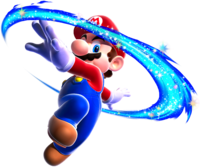
Mario appears again as the main protagonist of Super Mario Galaxy, having to save Princess Peach after she was kidnapped by Bowser during the Star Festival. Most of the jumping mechanics present in Super Mario 64 return, such as the long jump and the backward somersault. New powers include the Star Spin and the Star Pointer, which can be controlled independently from Mario. The Star Pointer can shoot enemies or grab Star Bits without controlling Mario. Additionally, Mario can get assistance by another player in Co-Star Mode, who can help gather Star Bits, shoot Star Bits, stun enemies, and assist in his jumping. Finally, Mario can find new sets of temporary power-ups that aid him in completing levels, providing him with new abilities, including but not limited to the Bee Mushroom, the Boo Mushroom, the Ice Flower, and the Spring Mushroom.
New Super Mario Bros. Wii
- “New Super Mario Brothers... Wii-hee!”
- —Mario, New Super Mario Bros. Wii
Mario's role and basic abilities in New Super Mario Bros. Wii remain the same as in its predecessor, although there are a few added power-ups, such as the Propeller Mushroom and the Penguin Suit. The story, while still basic, is slightly different—in the cutscene at the beginning of the game, Mario, Luigi, and many Toads, including Blue Toad and Yellow Toad, are celebrating Princess Peach's birthday when a cake suddenly walks into the castle. When Peach moves closer to the cake, Bowser Jr. and the Koopalings jump out of the cake and throw it onto Peach. Mario, Luigi, and the Toads then give chase, and Mario once again fights his way through eight worlds in his attempt to rescue Peach. After Mario rescues Princess Peach, the princess tells Mario about secret World 9, extending his adventure.
Super Mario Galaxy 2
- “Super Mario...Galaxy! Woo-hoo!”
- —Mario, Super Mario Galaxy 2
Super Mario Galaxy 2 has Mario involved as the main protagonist once again, following a more simplistic form of the original game's story. Aside from additional power-ups and the addition of Yoshi, the gameplay is also identical to the first Super Mario Galaxy game.
Super Mario 3D Land
InSuper Mario 3D Land Bowser kidnaps Peach while she checks the damage to a Tail Tree. Mario and the Toads then follow to try to rescue her. During the adventure, Mario battles several enemies old and new, including Boom Boom and Pom Pom. While running through the worlds, Mario receives letters from Peach to learn about her situation. Mario's adventure is a throwback to the classic 2D Super Mario adventures, relying on power-ups and his jumping to successfully clear levels, but merged with the 3D gameplay of later games as a new feature. He uses several classic power-ups, notably the Tanooki Suit from Super Mario Bros. 3. Unlike in older games, however, his default form is his Super form; whenever he loses a life, he restarts in this form rather than his Small form. His new abilities include rolling, which can break blocks if he is in Super form. He also has a few of his jumps from the 3D games, including the Long Jump, the Crouch Jump (which works like the Backward Somersault), and the Side Somersault.
New Super Mario Bros. 2
- “New Super Mario Bros.... 2!”
- —Mario, New Super Mario Bros. 2

Mario once again appears as the main protagonist of New Super Mario Bros. 2. In this game, Gold Mario (as well as the Gold Flower) is introduced as Mario's newest form. In this form, he can throw fireballs that transform solid objects (blocks) into coins for him to collect. It is also the introduction of White Raccoon Mario, a form obtainable from Invincibility Leaves gotten from Assist Blocks. The form gives Mario the power of invincibility and all of the abilities of Raccoon Mario.
There is another mode in the game, Coin Rush, in which Mario must collect as many coins as possible in three random courses within the time limit and without being defeated once. There are + Clocks scattered throughout the courses, while Mario also gets more time by hitting Checkpoint Flags. Reaching the top of the flagpole doubles Mario's coin count, and defeating enemies as Gold Mario or after a Gold Ring is triggered awards additional coins.
New Super Mario Bros. U / New Super Luigi U / New Super Mario Bros. U Deluxe
- “Oh, yeah! Mario time!”
- —Mario, New Super Mario Bros. U
Mario appears again as the protagonist in New Super Mario Bros. U. Once again, he must save the Mushroom Kingdom from Bowser and his minions as he travels with his allies Luigi, Blue Toad, Yellow Toad, and his new allies, Miis. This game introduces Super Acorns, which give Mario & co. a new form, Flying Squirrel Mario, when he collects them. In this form, Mario can glide and cling to walls. The upgraded P-Acorn allows him to fly indefinitely. His old power-ups, including but not limited to the Super Mushroom, Fire Flower, and Ice Flower, return. The Penguin Suit and Propeller Suit from New Super Mario Bros. Wii also return, but they are found only in certain Toad Houses and in Challenge Mode.
In this game, Mario discovers Baby Yoshis that aid him on his adventure by providing light, emitting bubbles, or floating. During his adventure, he encounters new enemies, including but not limited to Waddlewings, Nabbit, and Goombrats. To save Princess Peach, Mario must travel to a Koopaling's airship and defeat that Koopaling to proceed. When Mario finally arrives at Peach's Castle, it is conquered, and he must enter the modified castle to defeat Bowser and rescue Peach.
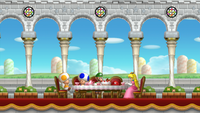
In the downloadable content New Super Luigi U, due to Luigi replacing Mario as the main protagonist, Mario himself does not appear, marking his only absence in the entire Super Mario series. His absence from the game is referenced in three instances: in the opening sequence, his cap appears on the table; at the beginning of the Frosted Glacier level Broozers and Barrels, a snowman with Mario's face and a cap with his "M" on it can be seen; and an object known as the Luigi Block has Mario's emblem on it (despite being named after Luigi).
Mario reappears as a playable character in New Super Mario Bros. U Deluxe. Mario remains a non-playable character in New Super Luigi U. When a Super Guide Block appears in New Super Luigi U, however, a computer-controlled Mario now appears to complete a level for the player.
Super Mario 3D World / Super Mario 3D World + Bowser's Fury
- “Super Mario...3D World!! Meow!”
- —Mario, Super Mario 3D World
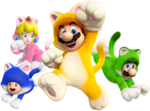
Mario returns in Super Mario 3D World and its Nintendo Switch port, Super Mario 3D World + Bowser's Fury, alongside Luigi, Princess Peach, and Toad, as an all-round character, in a similar way to Super Mario Bros. 2, lacking the special abilities and trade-offs of the other three characters. After Bowser has kidnapped the Sprixie Princesses, Peach falls into the pipe that leads to the Sprixie Kingdom, and Mario, Toad, and Luigi follow. There, they cooperate on their adventure to reach Bowser. During the adventure, Mario encounters new items, most notably the Super Bell, which transforms him into Cat Mario. He also encounters new enemies, such as Cat Goombas, and old enemies, including Chargin' Chucks. Boom Boom and Pom Pom also reappear to hinder Mario's progress, while new bosses, such as Hisstocrat, are additional impediments.
In the game's port's standalone story Bowser's Fury, Mario is the only character from Super Mario 3D World to be playable. He teams up with Bowser Jr. to collect Cat Shines and defeat a corrupted Bowser and restore him back to normal, which they do by collecting more Cat Shines that awaken a new power-up called the Giga Bell, one of the enhanced versions of the Super Bell that transforms Mario into Giga Cat Mario, which will allow him to grow to an enormous size to battle Fury Bowser. If he collects all 100 Cat Shines, his Cat form changes to match his Giga Cat form, Bowser Jr. and his Junior Clown Car become Cat variants of themselves, and Fury Bowser's spikes and hair change from orange to white, although all of these changes are simply aesthetic.
Super Mario Maker / Super Mario Maker for Nintendo 3DS
- “Hey! Let's get making!”
- —Mario, Super Mario Maker
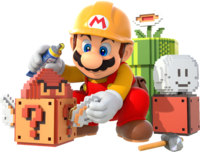
Mario appears as the sole playable character in the Wii U level-creation game Super Mario Maker. However, Mario can make use of Mystery Mushrooms to take on the appearances of a variety of other characters (including non-Mario characters). Also, a number of unlockable Mystery Mushroom costumes alter Mario's sprite to a different iteration of himself, listed below. In the Nintendo 3DS version of the game, Mario cannot do this due to the removal of the Mystery Mushroom.
 Mario (Super Mario Bros.): A recolor of Mario's original Super Mario Bros. sprite that uses his modern colors.
Mario (Super Mario Bros.): A recolor of Mario's original Super Mario Bros. sprite that uses his modern colors. Silver Mario (Super Mario Maker): A silver palette swap of Mario's modernized Super Mario Bros. sprite.
Silver Mario (Super Mario Maker): A silver palette swap of Mario's modernized Super Mario Bros. sprite. Gold Mario (Super Mario Maker): A golden palette swap of Mario's modernized Super Mario Bros. sprite.
Gold Mario (Super Mario Maker): A golden palette swap of Mario's modernized Super Mario Bros. sprite. Builder Mario (Super Mario Maker): An 8-bit rendition of the attire Mario wears on the box art and promotional art.
Builder Mario (Super Mario Maker): An 8-bit rendition of the attire Mario wears on the box art and promotional art. Dr. Mario (Dr. Mario): Mario's modernized Super Mario Bros. sprite modified to look like Dr. Mario.
Dr. Mario (Dr. Mario): Mario's modernized Super Mario Bros. sprite modified to look like Dr. Mario. Kart Mario (Super Mario Kart): Mario's original Super Mario Bros. sprite, modified to match his current colors, driving a Standard Kart from Mario Kart 8.
Kart Mario (Super Mario Kart): Mario's original Super Mario Bros. sprite, modified to match his current colors, driving a Standard Kart from Mario Kart 8. SUPER MARIO KUN (Coro Coro Comic): Mario's design from the Super Mario-kun manga, originally exclusive to Japan.
SUPER MARIO KUN (Coro Coro Comic): Mario's design from the Super Mario-kun manga, originally exclusive to Japan. Cat Mario (Super Mario 3D World): An 8-bit rendition of Cat Mario based on Mario's Super Mario Bros. sprite.
Cat Mario (Super Mario 3D World): An 8-bit rendition of Cat Mario based on Mario's Super Mario Bros. sprite. Frog Mario (Super Mario Bros. 3): Frog Mario's sprite from Super Mario Bros. 3.
Frog Mario (Super Mario Bros. 3): Frog Mario's sprite from Super Mario Bros. 3. Mario Trio (Mario & Luigi: Paper Jam): Mario, Luigi, and Paper Mario are shown as one sprite.
Mario Trio (Mario & Luigi: Paper Jam): Mario, Luigi, and Paper Mario are shown as one sprite. GLA (Mercedes-Benz/Mario Kart 8): Mario drives a GLA SUV.
GLA (Mercedes-Benz/Mario Kart 8): Mario drives a GLA SUV. Statue Mario (Super Mario Bros. 3): Statue Mario's sprite from Super Mario Bros. 3.
Statue Mario (Super Mario Bros. 3): Statue Mario's sprite from Super Mario Bros. 3.
Mario is also given two new forms: the first one is Weird Mario, which is a taller and skinnier version of him and has access to the Scuttle, and in addition to be a placeable form, will also "answer" Warp Doors if they are tapped five times. The other is Big Mario, which comes in two different versions: one with Mario's original colors and another with his modern colors. The form causes several enemies and items to gain traits of Mario (specifically his cap and his moustache).
Super Mario Run
Mario reappears in Super Mario Run as a playable character along with Luigi, Princess Peach, Toad, Toadette, the colored Yoshis, and Princess Daisy. Mario is the only playable character at the start of the game, but the others are unlocked as the player progresses through the game. Along with Luigi, Mario has a small form, allowing him to be hit twice before being defeated. Statues of Mario can also be bought at the shop and built in Kingdom Builder. A golden Mario statue is also available for purchase via My Nintendo.
Super Mario Odyssey
- “Super Mario...Odyssey!”
- —Mario, Super Mario Odyssey
Mario once again appears as the protagonist and the sole playable character (aside from Cappy in co-op mode) in Super Mario Odyssey. When Bowser kidnaps Peach again, Mario fights him on Bowser's airship. However, he is defeated by Bowser and crash-lands in the Cap Kingdom. He is later found by a Bonneter named Cappy, whose sister Tiara was also kidnapped by Bowser, and the two team up to save their respective loved ones. Cappy replaces the Mario Cap (which was torn apart during the fight), allowing Mario to throw him in one of his moves as well as use him to capture various characters, enemies, and objects. The two then have to travel across various kingdoms in order to catch up with Bowser and save Princess Peach.
Appearance-wise, Mario seems to have a similar design to that he possessed in Super Mario 3D World, albeit with more detailed textures, and he appears to be much smaller in height than other humans, as seen in New Donk City.[4]
Super Mario Maker 2
Mario reappears in Super Mario Maker 2 as the main playable character. Although he is no longer the only playable character, he is the only one playable in Story Mode. Mario has access to the Super Bell power-up, due to the addition of a Super Mario 3D World style. In addition, he can use the Super Hammer power-up in said style to turn into Builder Mario, as well as the Superball Flower in the Super Mario Bros. style, which previously appeared 30 years prior in Super Mario Land and turns Mario into Superball Mario. In the version 3.0.0 update, he also has access to the SMB2 Mushroom, which turns him into SMB2 Mario, giving him his appearance and characteristics from Super Mario Bros. 2.
Super Mario Bros. 35
Mario appears as a playable character in Super Mario Bros. 35, identical to his appearance from Super Mario Bros. He is also featured in multiple player icons.
Super Mario Bros.: Peach-hime Kyūshutsu Dai Sakusen!
Mario is featured in a feature-length anime adaption of Super Mario Bros., Super Mario Bros.: Peach-hime Kyūshutsu Dai Sakusen!. In this film, Mario and Luigi are portrayed as grocery store workers. Mario has his video game hijacked, and he notices Princess Peach. She escape the TV set, pleads for help, and gets kidnapped by King Koopa, dropping her Brooch. Mario quickly is attracted to her, and he and Luigi, while also traveling to the kingdom for riches, eventually follow Kibidango into a series of pipes, and exploring the Mushroom Kingdom to search for Princess Peach.
Family Computer Golf: Japan Course / Family Computer Golf: U.S. Course
Mario appears in Family Computer Golf: Japan Course where he is depicted in his normal overalls with his appearance akin to his normal design. In Family Computer Golf: U.S. Course, the companion of Family Computer Golf: Japan Course, Mario has a blue shirt and red-and-white striped overalls.
Famicom Grand Prix series
Famicom Grand Prix: F1 Race
Mario makes a playable appearance in the Japan-exclusive racing game, Famicom Grand Prix: F1 Race. Mario drives a Formula One car and can race alone or with a competition. Whenever Mario crashes into a wall or car or drives off-road, his car's fuel and health decrease. He can visit pit stops to repair and refuel his car, although this takes time. When Mario wins the Grand Prix, he earns money, which can be used to buy unlockable cars.
Famicom Grand Prix II: 3D Hot Rally
Mario and Luigi are drivers in Famicom Grand Prix II: 3D Hot Rally. The two drive one of the three vehicles: Kattobi, Yonque, or Monster. They must rally through the course, driving through checkpoints before the timer runs out. If they hit other cars, they severely slow down and can be knocked to the side if other cars bump them from there. In higher levels, their car may crash if they hit another car, which can make it more difficult to reach the checkpoint.
Alleyway
In Alleyway, similar to Breakout, Mario controls a paddle that deflects a ball to break a particular formation of bricks. During bonus rounds, various brick formations resembling sprites from Super Mario Bros., including Mario's sprite, are shown.
NES Open Tournament Golf
In NES Open Tournament Golf, taking place on Earth, Mario retains his blue shirt and red-and-white striped overalls. Princess Peach is depicted as Mario's caddy, who helps carry Mario's golf equipment.
DIC cartoons
In the Mario cartoons produced by DIC Entertainment, Mario and Luigi are shown to be plumbers from Brooklyn. According to the first two animated series, Mario and Luigi arrived in the Mushroom Kingdom while out on a house call; they are shown working on a bathtub in an old woman's house when they are suddenly sucked down the drain, transporting them to the Mushroom Kingdom, where they save Princess Toadstool from King Koopa for the first time. The series depicts Mario as the pasta-loving older brother of Luigi.
The Super Mario Bros. Super Show!
- “Hey, paisanos! It's The Super Mario Bros. Super Show!”
- —Mario, The Super Mario Bros. Super Show!
The Super Mario Bros. Super Show! shows both Mario's and Luigi's lives in the real world and their lives in the Mushroom Kingdom, through both live-action and animated episodes. In the live-action portion of the show, Mario and Luigi (portrayed by Lou Albano and Danny Wells, respectively) are plumbers living in Brooklyn, working from Mario Brothers Plumbing, their basement workshop doubling as their home. They are shown as being financially unsuccessful, barely being able to get by. In some segments, Mario is shown to have disdain for his life; in the episode "Baby Mario Love," Mario is shown complaining about his life being dull, not having any glitz or glamour.
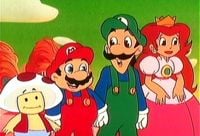
In the animated segments, Mario and Luigi are traveling across the Mushroom Land with Toad and Princess Toadstool, searching for anyone or anything that can both rid the kingdom of King Koopa and send Mario and Luigi back home to Brooklyn. According to the first episode, "The Bird! The Bird!", they begin their quest shortly after Mario and Luigi have saved Princess Toadstool after arriving in the Mushroom Kingdom.
Similar to King Koopa, Mouser, and Tryclyde, Mario may occasionally employ disguises or aliases during an animated segment.
- Butch Mario from "Butch Mario & The Luigi Kid"
- Captain Kiddler from "Pirates of Koopa"
- Sherlock Mario from "The Adventures of Sherlock Mario"
- Mighty McMario from "Mighty McMario and the Pot of Gold"
- Zero from "The Mark of Zero"
- Marzan from "Mario of the Apes"
- The Provolone Ranger from "The Provolone Ranger"
- Indiana Mario from "Raiders of the Lost Mushroom"
- Crocodile Mario from "Crocodile Mario"
- Mario Skywalker from "Star Koopa"
The Adventures of Super Mario Bros. 3
Template:Appeared The Adventures of Super Mario Bros. 3 follows the events of The Super Mario Bros. Super Show! This series of episodes is based on Super Mario Bros. 3, including Mario, Luigi, Princess Toadstool, and Toad engaging King Koopa and his children, the Koopalings, the new major antagonists of the show. In this series and in the next and final animated series of the DiC trilogy, Super Mario World, Mario is portrayed by Walker Boone. The only episode Mario does not appear in is "Life's Ruff."
Super Mario World
Template:Appeared Template:Quote2 The Super Mario World television series is a continuation of the previous series, The Adventures of Super Mario Bros. 3. This time, the episodes focus loosely on the video game Super Mario World with added characters, the most prominent being Yoshi, the Cave People, and Oogtar. Mario appears in every episode of the Super Mario World television series as one of the main protagonists.
Mario Ice Capades
Mario appears in the "show on ice" television special Mario Ice Capades. In the show, Bowser plans to use the NES to infect computers with viruses. After being summoned by Princess Toadstool, Mario and Luigi appear and fight Bowser's troops consisting of two Koopa Troopas, two Goombas, a Hammer Brother, a red Koopa Paratroopa, and a Spiny. For the final fight with Bowser, Mario and Luigi get children from the audience to assist them, handing them plumber tools for them to use as weapons. After their victory, Princess Toadstool awards them the "Purple Plunger for Bravery."
Mario and the Incredible Rescue
The children's book Mario and the Incredible Rescue has Mario teaming up with Luigi, Toad, and eventually Yoshi to rescue Princess Peach. In the events of the book, Bowser has amassed an army of ghosts (Boos) by stealing (and using) The Book of Spells from a sorceress named Cybele. Upon speaking with Cybele, Mario, Luigi, and Toad learn that to defeat Bowser and his army of ghosts, he has to collect six magic mushrooms that contain special powers. Eventually, Mario and his friends collect all six mushrooms, fight Bowser, and successfully rescue the princess.
Super Mario World: Mario to Yoshi no Bōken Land
Mario is one of the main characters in the interactive OVA Super Mario World: Mario to Yoshi no Bōken Land. The video follows the story of Super Mario World rather closely, though it is quite condensed. Mario leads a group on a quest to save Princess Peach from King Koopa. He is shown to be the bravest of the group, with Luigi and Yoshi less so. He often calls the viewer to ask questions.
Dr. Mario series
- Main article: Dr. Mario
Template:Quote2 Mario takes in a different alias in the first game of the puzzle subseries, Dr. Mario. Mario works alongside Nurse Toadstool (Princess Peach) at the Mushroom Kingdom Hospital to combat three types of viruses: Fever, Chill, and Weird. Here, he must drop Capsules to destroy these viruses.
Dr. Mario 64 features a story behind the gameplay. During a flu outbreak, Dr. Mario attempts to use his Megavitamins to heal the citizens. Wario, however, wishes to steal and profit from the Megavitamins. Mad Scienstein intervenes and takes the Megavitamins, so after Dr. Mario beats Wario, the two follow Mad Scienstein, defeating enemies from Wario Land 3. Mad Scienstein then reveals himself to be a worker for Rudy, who is afflicted with the cold. Dr. Mario proceeds to cure Rudy after beating him, though. If Dr. Mario has not lost any matches, however, Wario takes the Megavitamins and transforms into Vampire Wario. On the other hand, if the player is using Wario, Dr. Mario becomes Metal Mario after ingesting the pills.
Dr. Mario Online Rx has similar gameplay to the original Dr. Mario, although there is an additional Virus Buster minigame. Dr. Mario Express is similar to Dr. Mario Online Rx but features no Virus Buster minigame.
In Dr. Mario World, Dr. Mario hunts down viruses to save infected Koopa Troopas, Toads, and Shy Guys after a virus outbreak happens in the Mushroom Kingdom. Other Mario characters join him as playable characters.
Amada Anime Series: Super Mario Bros.
The Amada Anime Series: Super Mario Bros. series of Japan-only anime features Mario characters in classic fairy tale settings and with alterations. Mario plays as the main protagonist, defeating Bowser in all of them. Super Mario Momotarō retells a popular Japanese folklore called Momotarō, with Mario playing the role as the main hero who is born from a peach and is raised by elderly Hammer Bros. Super Mario Issun-bōshi retells the Japanese folk tale Issun-bōshi, where Mario plays the role of a small hero who is only one inch tall. Super Mario Shirayuki-hime is the final story of the series, based on Brothers Grimm's Snow White, where Mario protect Princess Peach from the evil Queen Koopa, who is Bowser.
White Knuckle Scorin'
The comic that is released alongside the White Knuckle Scorin' CD album is a loose adaptation of Super Mario World. Mario and Luigi vacation in Dinosaur Land, but Bowser kidnaps Princess Peach as part of his plan to convert Dinosaur Land to fossil fuel and become an oil tycoon of OPEC. While Princess Peach tries to send messages, Mario helps teach Yoshi how to read, which is later integral for relaying Peach's messages as well as reciting spells from Bowser's magic book.
Super Mario Bros. & Friends: When I Grow Up
Mario appears in various scenes of the virtual coloring book, Super Mario Bros. & Friends: When I Grow Up. He and various other Mario characters (and Link) are shown in various occupations.
Mario Teaches Typing series
Mario helps children type in both Mario Teaches Typing and Mario Teaches Typing 2. By typing correctly, players enable the game to advance. Mario Teaches Typing 2, the sequel, has another story. Mario and Luigi find a Magical Typewriter. The note attached to it explains that it is essential to beat Bowser. If one types the correct sequence into the scroll, a spell is cast and defeats Bowser. If it is used incorrectly, however, the typewriter self-destructs. Mario attempts to type, but he fails and the typewriter explodes, sending its pieces to various regions. The two adventure, retrieving the pieces while improving their typing abilities, eventually restore the typewriter, and cause a giant typewriter to fall on top of Bowser's Castle.
Super Mario-kun
Mario has played a starring role on a long-running manga series, Super Mario-kun. As the manga series is based on the games, Mario often plays the same role as he did in the games. The manga volumes typically depict Mario along with Yoshi or Luigi, although he sometimes befriends other partners to aid him. There are some major alterations in some portrayals, however, such as the Donkey Kong Country arc, where Mario does make an appearance, or in Super Mario World 2: Yoshi's Island, where Mario's and Luigi's adult selves aid Yoshi and Baby Mario to save Baby Luigi.
Mario is depicted as playful, brave, and devoted to his friends, although immature, rash, and sometimes mischievous. Unlike in the games, Mario frequently scolds or teases his friends for failing or otherwise making simple gags. Mario, as well as his friends, is playful with his visual gags, pop culture references, and wordplay, and can even engage in crude humor such as farting to taunt his opponents or urinating on Yoshi.
Yoshi franchise
Yoshi
Mario is featured in the first game of the Yoshi franchise, entitled simply Yoshi (or Mario & Yoshi). The gameplay is similar to that of Tetris: Mario holds several enemies and must align them vertically to eliminate them and score points. Mario can also match egg halves vertically (even with enemies in between) to create a Yoshi's Egg that hatches a Baby Yoshi, giving Mario 50 points. The Yoshi that Mario can hatch is dependent on the enemies between the egg halves.
Yoshi's Cookie
Mario is portrayed as a baker in another puzzle game of the Yoshi franchise, Yoshi's Cookie, along with its remake in Nintendo Puzzle Collection. The title screen of the NES and Game Boy versions shows a small narrative: Mario fails to open a cookie jar, but when he gets an idea and leaves, Yoshi enters and eats the jar. Mario then chases Yoshi with a hammer. When Mario returns with the cookie jar, however, the jar is empty. In the game, Mario must clear rows and columns of cookies by matching them. There are six types of cookies he must match. Mario can also face against Princess Peach, Yoshi, or Bowser in the VS mode of the game, where he must maintain a higher lit fuse than his opponent by clearing rows of cookies. Matching five Yoshi Cookies gives a special move that can disrupt the opponent's playing field.
Super Mario Adventures
Mario is the main character of Super Mario Adventures, a 10-part series of comics that features Mario and Luigi attempting to rescue Princess Toadstool, as well as other characters and elements from Super Mario World. In the comics, Mario and Luigi head to Princess Toadstool's castle to attempt to fix the plumbing, but Bowser and the Koopa Troop, who are responsible for the pipe problem, ambush them. Turning Mario to stone, Bowser and his army kidnap Princess Toadstool so Bowser can marry her. After recovering from his stone form, Mario teams up with Luigi, and they follow the pipes to rescue Princess Toadstool. Along the way, they attempt to cook an egg, but they accidentally encounter Yoshi when the egg hatches. Unlike in many video games, Mario gets captured twice, and he needs to be rescued by both Princess Toadstool (who escapes the first time, but gets recaptured later and put in a trance) and Luigi. Other characters Mario and Luigi encounter include Friendly Floyd, a businessperson who swindles the Mario Bros.' money; however, his services help Luigi devise a disguise to rescue Mario by dressing as Princess Toadstool. Mario and Luigi also encounter Boos in a ghost house, where Mario disguises himself as a psychiatrist to help comfort the Boos and escape the ghost house.
Mario Paint
Mario plays a minor role in Mario Paint. Aside from generally serving as the game's mascot, Mario appears on the interactive title screen and on several icons that appear throughout the game. Mario's icon in the music mode indicates a piano-like instrument. In Gnat Attack, Mario's head is the second icon added to the top left corner of the screen, after levels 1 through 3 are completed five times in a row.
Mario Kart series
- “Welcome to Mario Kart!”
- —Mario, Mario Kart 64
In the Mario Kart series, both in the mainline series and the Mario Kart Arcade GP arcade series, starting with Super Mario Kart, Mario has always been a playable character and, except in Mario Kart Tour, is usually available at the start. In games where characters are divided into weight groups, Mario is a middle-weight character with all-around stats. Numerous racecourses throughout the series have been named after Mario, usually as Mario Circuit.
In the first installment, Super Mario Kart, when Mario is a CPU, he sometimes uses Star power, which gives him invincibility. In Mario Kart: Double Dash!!, he is grouped with Luigi by default, with art always showing him as the driver, and their special item is the Fireball, which splits into five smaller fireballs and spins out any racer that the fireballs hit. His kart is the Red Fire, which is an all-around kart.
In Mario Kart Arcade GP, Mario shares his special character items with Luigi. His special items are a Star, which gives Mario invincibility; a fireball, which can be shot forward or backward to damage a kart; the hammer, which can hit a rival, giving them damage; and the Chain Chomp, which provides damage to any kart it hits. In Mario Kart Arcade GP DX, his personal kart is the Lightning Champ. He also receives a Fire Mario alternate palette swap.
In Mario Kart DS, Mario's karts are the B Dasher, the Standard MR, and the Shooting Star. After the player beats the game, Mario, as well as the rest of the roster, can race in any of the karts. He also fights two bosses in Mission Mode: Eyerok in Level 2 and Wiggler in Level 7. Mario is also used to race a special red car in Shroom Ridge.
In Mario Kart Wii, Mario also provides a boost to handling, weight, and acceleration on any vehicle he drives. Mario's stats in Mario Kart 8 are also not perfectly balanced. His top speed and traction are his strongest stats, while his acceleration is his weakest stat. If Mario drives certain vehicles, they are colored red to match Mario's color. The exceptions are his gray GLA and his white City Tripper (though with red accents). Unlike in Mario Kart Wii, all characters can ride on any vehicle in the game.
Mario reappears in Mario Kart Tour as an unlockable Super driver. His special skill is the Fire Flower. Mario also has a self-titled cup in the game, as well as self-named tours and Team Rally tours against Luigi and against Peach.
Mario has several variants of himself appear. Baby Mario makes his debut in Mario Kart: Double Dash!! Robo Mario also appears as a rival in Mario Kart Arcade GP. Metal Mario makes his debut in the Mario Kart series in Mario Kart 7 and has been described as a rival on the American website for Mario Kart 7. Mario Kart Tour additionally introduced a number of High-End variants of Mario, with most of them being based on his outfits from Super Mario Odyssey.
- Mario (Musician): From Super Mario Odyssey, he has the Double Bob-ombs special skill and was available as of the New York Tour.
- Mario (Hakama): From Super Mario Odyssey, he has the Coin Box special skill and was available as of the Tokyo Tour.
- Mario (Santa): This variant is added in the 2019 Winter Tour, with the Fire Flower being his special skill (like his normal counterpart).
- Mario (Happi): From Super Mario Odyssey, he has the Bob-omb Cannon special skill and was introduced in the 2020 New Year's Tour.
- Mario (Classic): Mario has the Triple Mushrooms special skill and is available as of the Mario Bros. Tour.
- Mario (Chef): From Super Mario Odyssey, based on the chef outfit from Yoshi's Cookie, he has the Lucky Seven as his special skill and is introduced in the Cooking Tour.
- Mario (Swimwear): From Super Mario Odyssey and introduced in the Marine Tour, he has the Dash Ring as his special skill.
- Mario (SNES): This variant is based on Mario's sprites from Super Mario Kart, and he appears as of the Super Mario Kart Tour with the Triple Mushrooms as his special skill.
- Mario (Sunshine): From Super Mario Sunshine, he has the Giant Banana special skill, and he appears as of the 2020 Los Angeles Tour.
- Mario (Halloween): This variant has the Lucky Seven for his special skill and was added in the 2020 Halloween Tour.
- Mario (Racing): From Super Mario Odyssey, he has Triple Mushrooms special skill and was introduced in the 2021 Mario Tour
- Mario (Tuxedo): From Super Mario Odyssey, he has the Coin Box special skill and was introduced in the Wedding Tour.
- Mario (Baseball): From Super Mario Odyssey, he has the Mushroom Cannon special skill and is introduced in the 2021 Los Angeles Tour.
- Mario (Satellaview): From Super Mario Odyssey, he has the Lucky Seven special skill and is introduced in the 2021 Space Tour.
- Mario (Golf): A variant of Mario in his golf outfit originally from Family Computer Golf: U.S. Course and NES Open Tournament Golf but introduced in Super Mario Odyssey was introduced in 2022 Los Angeles Tour.
- Mario (Aviator): From Super Mario Odyssey, he has the Dash Ring special skill and was introduced in the Sky Tour. Also parsed as Aviator Mario.[5]
- Mario (Samurai): From Super Mario Odyssey, he has the Boomerang Flower special skill and was introduced in the Samurai Tour.
- Mario (King): From Super Mario Odyssey, he has the Coin Box special skill and was introduced in the Anniversary Tour.
In total, Mario has 17 different playable variants (not including Metal Mario, Ice Mario, Builder Mario, Dr. Mario, Penguin Mario, Tanooki Mario, and Cat Mario), making him the driver in Mario Kart Tour with the most playable variants. He also has multiple victory animations depending on which variant the player uses. His Builder variant holds up his hammer, then nods his head; his musician variant waves his hat in the air; his Sunshine variant dances in his seat; his Halloween variant looks around, then playfully giggles; and his Satellaview variant performs an astronaut's wave.
For ways in which Mario and his variants have been obtainable throughout the game's history, see List of availabilities for Mario in Mario Kart Tour.
Mario and Luigi are the two fully playable characters in Mario Kart Live: Home Circuit. As in Mario Kart Tour, alternate variants are available, though they are only cosmetic.
Mario Discovery series
Mario travels to different worlds to teach basic learning skills to younger players in the Mario Discovery series. Mario is controlled by a cursor interacting with an object.
Mario is Missing!
The 1992 game Mario is Missing! was the first game in the Mario Discovery Series[6] of Educational Games and set the Mario characters on Earth. When hearing of Bowser's plan to flood the Earth by melting Antarctica's ice with hair dryers, Mario, Luigi, and Yoshi head to Bowser's Castle in the Antarctic. Mario is captured, although his capture varies between versions of the game.
In the DOS version, Mario enters the castle alone, as Luigi is too scared to follow. Mario meets Bowser, who is in a butler disguise, and accepts candy from him, despite Luigi's warning not to take candy from strangers. Bowser uses this as a distraction to trap Mario in a net. Despite his captured status, however, Mario in that version nonetheless manages to give contact to Luigi to guide him to the continents to stop Bowser's plans, as well as update him on the situation. Over the course of the game, Mario tells Luigi that he admitted to Bowser that he has a fear of the dark, which strained communication since Bowser is threatening him with his fear. In the NES version, Mario is captured outside in the snow by a Koopa with a bag. In that version, he also reacts angrily to the title shortly before being captured by the Koopa. In the SNES version, Mario gets trapped inside a pitfall outside the castle.
The game centers around Luigi, who rescues Mario from Bowser in the end.
Mario's Time Machine
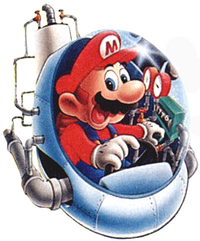
In Mario's Time Machine, Bowser uses a time machine to steal various artifacts from different time periods of human history in order to display them at his museum. Mario goes on a mission to return all objects of Bowser's museum to their original time periods in order to prevent history from being altered. Additionally, Mario has to rescue Yoshi from Bowser in the NES version of the game. Mario's Time Machine is one of the few games in which Mario talks.
In the NES version, the player has to play an altered version of Mario Bros. to defeat Koopa Troopas, who drop the stolen objects when defeated. Mario then has to travel back in time to return the objects to their proper places in a side-scrolling mission.
In the SNES version, Mario has to pick a stolen object from the museum and then go to a "Time Surfing" level to collect enough Mushrooms to make a time jump, then return the objects to their proper places.
Yoshi's Safari
In Yoshi's Safari, Mario and Yoshi are sent by Princess Peach to rescue Jewelry Land from Bowser's occupation. In this game, Mario uses a gun called the Super Scope (controlled by the player with said accessory for the Super Nintendo) to shoot enemies while riding on Yoshi's back. Mario fights the Koopalings and Bowser to free King Fret and Prince Pine of Jewelry Land.
Mario & Wario
In Mario & Wario, Mario is a passive character. Wario drops buckets or barrels or similar objects on his head, blinding him. The fairy Wanda has to guide Mario safely to Luigi through hazards and traps in each level. When arriving at the end of the level, Luigi frees Mario from the sight-blocking object. Mario is only one of the characters that have to be guided through levels by Wanda like this in the game. The other characters are Princess Peach and Yoshi. Mario walks at a medium speed, while Peach is slow and Yoshi is fast.
Wario Land: Super Mario Land 3
Although Wario Land: Super Mario Land 3's title has Mario's name in it, Wario is the protagonist of this game. Mario is mentioned as one of Wario's motivations to go on a treasure hunt in the game's manual. Mario himself makes a small appearance at the end of the game, where he steals a Princess Peach statue from Wario.
Mario's Picross series
Mario is featured as an archaeologist in Mario's Picross, a puzzle game where Mario must scrape squares according to the numbered indicators on each column and row. Completing the puzzle correctly usually shows an image, sometimes referring to earlier games in the Mario series. During the gameplay, Mario is also given hints such as an entire row being scraped correctly or a roulette that determines which lines are revealed. Mario reappears in the sequel, Picross 2, where now, he must match boxes and link them to form specific images. Mario again appears in Mario's Super Picross on the Super Famicom. As in Picross 2, Wario also appears in the game. Mario is given a set of rules, where he works under a time limit and gets penalized if he makes a mistake. Wario, on the other hand, has no time limit, but mistakes are not apparent and no hints are given.
Hotel Mario

In Hotel Mario, Mario and Luigi travel to the Mushroom Kingdom after an invitation for a picnic by Princess Peach. Upon arriving, the two find out that Peach has been kidnapped by Bowser, who has made her a "permanent guest" in one of his seven Koopa hotels. Mario and Luigi travel from one Koopaling's hotel to the next, with Peach being brought to a new hotel every time the brothers have searched through the last one. After destroying most of the Koopaling hotels, Mario fights Bowser in his own hotel and defeats him. He then receives a kiss from Princess Peach, then congratulates the player as "the best ever."
In the game, Mario has to close all doors in a hotel in order to proceed. Mario can stomp on enemies to defeat them, similar to in the Super Mario series. He can also hide in open doors and take elevators to change his level.
Mario has four fingers in this game, instead of five as he usually does.
Yoshi's Island series
- Main article: Baby Mario
The Yoshi's Island series takes place while Mario and Luigi are babies, who are referred to as Baby Mario and Baby Luigi, respectively. In entries of those series, the stork delivers Baby Mario and Baby Luigi to their parents but is intercepted by Kamek. He succeeds in capturing only Baby Luigi and the stork, while Baby Mario is rescued by Yoshi. The goal of the series is for Yoshi to rescue Baby Luigi so the stork can safely reunite the two brothers to their parents.
Adult Mario appears as a high score icon in Yoshi Touch & Go.
In Yoshi's New Island, adult Mario is disguised as a live Warp Pipe named Mr. Pipe, and he helps Yoshi and Baby Mario by giving them needed items. He reveals himself in the end credits, where he eventually vanishes, presumably going back to his own time period.
Donkey Kong Country series
Donkey Kong Country 2: Diddy's Kong Quest
Mario makes a cameo appearance in Donkey Kong Country 2: Diddy's Kong Quest. He appears at the end of the game as one of Cranky's Video Game Heroes, along with Diddy Kong, Link, and Yoshi. With 39 DK Coins in the original and 67 in the Game Boy Advance version, Mario is the top video game hero.
Donkey Kong 64
In Donkey Kong 64, specifically in a port of the original Donkey Kong game, playable via an arcade set up in Frantic Factory, Mario re-enacts his initial role. Mario has to go through the same construction site as in the original game, while the old Donkey Kong creates mischief down Mario's path. However, a slight modification has been brought to this port, which is related to the game's objective. In the first run, Mario has to rescue Pauline from Donkey Kong; however, after she is rescued and the player restarts, Mario can instead collect a special Nintendo Coin at the end.
Excitebike: Bun Bun Mario Battle Stadium
Mario is a playable character in a Mario-styled remake of Excitebike in Excitebike: Bun Bun Mario Battle Stadium. He competes with other racers to try to place third or higher. He appears to have no differences from the other racers.
Mario's FUNdamentals
Mario has also appeared in Mario's FUNdamentals, where he plays several games with younger players, such as "Go Fish," "Checkers," "Backgammon," "Dominoes," and "Yahtzee." This is the first video game where Charles Martinet, the current voice actor for Mario, was credited for providing his voice.
Mario Tennis series
Mario is a playable character in all games of the Mario Tennis series. In all direct games in the series—Mario Tennis for the Nintendo 64, Mario Power Tennis for the Nintendo GameCube and Wii, Mario Tennis: Power Tour for the Game Boy Advance, Mario Tennis Open for the Nintendo 3DS, Mario Tennis: Ultra Smash for the Wii U, and Mario Tennis Aces for the Nintendo Switch—he is an all-around character. In Mario Tennis for the Game Boy Color, Mario is an unlockable character, unlocked by completing the Singles Mario Tour.
Mario Tennis
In Mario Tennis, Mario is an all-around playable character, and he has several themed courts including the Mario Bros. Court, the Mario & Luigi Court, and the Super Mario Court. In the doubles version of tournament mode, his AI doubles partner is Luigi. Additionally, if Peach is the human player, Mario is her partner.
If Mario is not playing in a match, he appears as the referee. A clone of Mario wearing a blue cap replaces his role as a referee if Mario is playing in a match; however, this clone is always the referee during the Star Cup and Planet Cup, regardless of whether or not Mario is playing. The referee wears different outfits depending on the tournament.
Mario is also the announcer in this game, which is the only game in the Mario Tennis series where he takes this role.
Mario Power Tennis
In Mario Power Tennis, Mario and Luigi are the only all-around characters. Unlike in other games, Mario and Luigi have subtle differences within each other. While they have nearly identical movement speed, Mario has more power, while Luigi has slightly more reach and more control. Mario, when compared to other characters, has a slightly below-average reach and lunge because of his short stature. Mario is stronger than most non-power characters. All his other stats are average. Mario's Offensive Power Shot has his racket transform into a giant mallet, which enables him to hit the ball with high speed and force; opponents that return the ball may get blasted to the back of the court. Mario's Defensive Power Shot is a simple spin that allows him to reach lobs and faraway balls quickly, but it is one of the few Defensive Power Shots that fail when the ball is too far away. Mario's taunt is him waving and saying, "Come on!"
Mario has appeared occasionally in several trophy-earning ceremonies in Mario Power Tennis. While Mario has appeared more than most characters in these ceremonies, Luigi appears in most trophy-earning ceremonies.
During the opening cinematic, Mario returns the ball that gets past Wario and Waluigi, allowing him and Luigi to win the opener of the tournament. During the night of the final match, Mario and Luigi are about to face off against Yoshi and Donkey Kong, but their opponents fail to show up, as Wario and Waluigi appear instead. Wario and Waluigi launch a full-scale assault by throwing Bob-ombs, while Mario and Luigi use their tennis rackets to knock back the explosives, which causes significant damage to the Peach Dome in recoil. After Bowser from his balloon launches a Bullet Bill, Mario knocks it back to Wario and Waluigi. Mario is unharmed during the chaos, even after Bowser's balloon generated an explosion that nearly wiped out the venue and the rest of the inhabitants inside.
Mario Tennis Open
In Mario Tennis Open, Mario shares nearly identical stats from Mario Power Tennis. Mario's metal form, Metal Mario, also appears as a Power character. Miis in the game can wear tennis clothing based on Mario, and if they win the singles Final Cup, they can wear his costume as well.
Mario Tennis: Ultra Smash
In Mario Tennis: Ultra Smash, Mario's tennis racket color is slightly different in this game; rather than being a solid blue, Mario's racket is predominantly red and blue with some white.
Mario Tennis Aces
In Mario Tennis Aces, Mario by default wears a new tennis outfit. However, his standard outfit could be unlocked by either participating in the online tournament demo or accumulating 500 participation points in the January 2019 online tournament. Also, Mario was among the characters that could be played as in the online tournament demo. During the game's adventure mode, Mario is, for most of the missions, the playable character as the player must collect the five Power Stones to stop Lucien. As of the game's version 2.0.0 update, the player can unlock a costume for Mario that has him wielding a Lucien replica while wearing his tennis outfit by completing Last Trial Boss Challenge.
Super Mario RPG: Legend of the Seven Stars
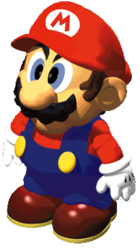
Mario appears as the main protagonist in Super Mario RPG: Legend of the Seven Stars. Mario first arrives to confront Bowser, who has again captured Princess Toadstool (which by now is a recurring event). Mario battles Bowser atop a Kinklink and rescues Toadstool. Then a huge sword, Exor, strikes the castle from atop and knocks them all to various spots in Mario's world. Mario falls through the pipe on top of his house and lands on his bed.
Mario discovers that the Star Pieces of the wish-granting Star Road are being sought by a group called the Smithy Gang, run by Smithy, who are causing havoc throughout the world. On this adventure, Mario recruits Mallow, Geno, Princess Toadstool, and even Bowser. They travel through much of the world, finding Star Pieces, which are protected by the Smithy Gang's strongest members. After all Star Pieces are collected, Mario fights Smithy. Mario reaches it through Bowser's Keep, which is inaccessible because Exor destroyed the bridge. With the help of Mallow's parents, King and Queen Nimbus, Mario has passage through a special cloud bus. When they finally arrive, Mario defeats Exor and goes to Smithy's dimension via Exor's mouth.
Mario's journey is not over since Smithy has even more minions at his disposal. After many battles, Mario faces and defeats Smithy, saving the Star Road.
Kirby series
In Kirby Super Star and Kirby Super Star Ultra, a golden statue of Mario is one of the possible transformations Kirby or his helper can take by using the Stone ability. Mario can also be seen in the crowd when Kirby is fighting King Dedede or participating in Megaton Punch. He is also seen in the credits of both Milky Way Wishes and Revenge of the King, in the form of a golden statue in Kirby Super Star, and performing a peace sign in front of the Nintendo logo in Kirby Super Star Ultra. In Kirby: Planet Robobot, Mario returns as a golden statue transformation of the Stone ability.
Mario Party series
- “I've-a got it! The Stars will help us end their fight! We'll throw a Mario Party to fill the Star Bank!”
- —Mario, Mario Party 6
Mario is one of the playable characters in the Mario Party series, appearing in all games thus far along with Luigi, Peach, and Yoshi. He is always represented by his trademark red color. Mario can compete in minigames to win coins (or Mini Stars, in Mario Party 9 and in Star-Crossed Skyway in Mario Party: Island Tour), which ultimately can help him earn Stars. In the first three Mario Party games, Mario aims to become the superstar, the character with the most Stars, coins being the tiebreaker. Though Mario has no distinguishable traits from the other Mario Party characters, the most notable difference is Mario's ability to use the Fireball Orb in Mario Party 7. Additionally, Mario's default Duel Mode partner is Koopa Troopa in Mario Party 3, and the booklet says that his favorite item is the Golden Mushroom, which increases the likelihood of his purchasing one if he is CPU-controlled. In Mario Party 3, he also challenges the player for the Courage Star Stamp if he is not used. In Super Mario Party, Mario's Dice Block has one 1, three 3's, one 5, and one 6, making it very balanced, although odd numbers are very common, making it more predictable where Mario will land in the Partner Party mode.
Super Smash Bros. series
| Super Smash Bros. fighter History of Mario |
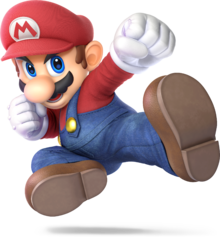
|
| Game appearances |
|---|
| Super Smash Bros. Super Smash Bros. Melee Super Smash Bros. Brawl Super Smash Bros. for Nintendo 3DS Super Smash Bros. for Wii U Super Smash Bros. Ultimate |
| Special moves |
| Neutral: Fireball Side: Cape Up: Super Jump Punch Down: Mario Tornado (64, Melee); F.L.U.D.D. (Brawl onward) Final Smash: Mario Finale |
| Battle entrance |
| Mario jumps out of a Warp Pipe and exclaims, "Let's-a go!" |
Mario has been playable in every Super Smash Bros. game to date. Mario is usually portrayed as a "main" character alongside Link, Kirby, and Pikachu, roughly depicted as the most prominent character and face of the games until Ultimate, where he and Link share mascot status and Kirby is the closest thing to a main character in World of Light. Mario has retained his balanced abilities even when fighting characters from other series. Due to his balanced playstyle, Mario's skill is reflected by the player, as mentioned by the Adventure mode Mario trophy. Also, as a result of his balanced design, Mario is also typically chosen for the "template" character; in Super Smash Bros., as well as all subsequent Super Smash Bros. installments, he is shown in the "How to Play" video; in Super Smash Bros. Brawl, players use him when testing changes in Stage Creator; and in Super Smash Bros. for Nintendo 3DS and Super Smash Bros. for Wii U, his silhouette is an opponent character for special move demonstrations. He is also used for controller mapping testing and is part of the gauge when players select the level of intensity in Classic Mode. Mario's moveset consists of quick short-ranged attacks, such as punches, kicks, and even head attacks. Mario's weight in Super Smash Bros. and Super Smash Bros. Melee is 100 units; starting from Super Smash Bros. Brawl, his weight is decreased to 98 units. Mario's victory theme throughout the series, which is shared with the rest of the Mario characters (except Rosalina), is an arrangement of the level clear theme from Super Mario Bros.
Most of Mario's moveset remains the same throughout the games, though his forward smash has been altered from a fist-inflating punch to an explosive palm blast (used from Super Smash Bros. Melee onward). Additionally, his spinning kick forward aerial is replaced with a downward hook from Melee onward, while the Mario Tornado has been used as his down aerial since Brawl.
Mario's alter-egos Dr. Mario and Metal Mario have also made appearances, with Dr. Mario being playable in Super Smash Bros. Melee, Super Smash Bros. for Nintendo 3DS, Super Smash Bros. for Wii U, and Super Smash Bros. Ultimate. Mario also makes additional trophy, sticker, and spirit appearances such as his Mario Strikers incarnation, his Raccoon form, and him driving a vehicle.
Super Smash Bros.
Template:Main-external In Super Smash Bros., Mario's standard moveset is inspired from Super Mario 64; his standard attack is the Punch + Punch + Kick combo, his dash attack is the Slide Kick, his down smash is the Sweep Kick, and finally, his back throw is the same throw he uses against Bowser. His special moves are Fireball, a bouncing fireball; Super Jump Punch, which has him jump, causing coins to fly out when in contact with enemies; and Mario Tornado, which has him spinning rapidly. Luigi serves as a clone of Mario, having the same moveset but with different properties, although in later games, he would be replaced by Dr. Mario.
Super Smash Bros. Melee
Template:Main-external In Super Smash Bros. Melee, Mario gains a side special move: Cape, a cape swipe that reflects projectiles. In contrast to his appearances in most games, he has a very serious and stern look on his face, despite the fact that he is normally portrayed as a cheerful person. Dr. Mario is introduced as a playable character, having near-identical moves.
Super Smash Bros. Brawl
- “Oh yeah! HIYAHHHHHHH...!!!”
- —Mario, Super Smash Bros. Brawl
In Super Smash Bros. Brawl, like every other character, Mario is given a Final Smash, which is named Mario Finale. This move launches a slow-moving two-streamed blast of fire that hits multiple times. Opponents that come in contact with the blast are knocked slightly to the side, and are thus forced to travel in the blast's direction. His down special move, Mario Tornado, was replaced by F.L.U.D.D., which sprays water that can push opponents.
While he does not appear as Dr. Mario, unlike in the previous game, Dr. Mario's name can be found in the files for the game along with 6 other characters.
Mario also plays a role as one of the several protagonists in the story mode of The Subspace Emissary and is one of the earliest characters shown and is one of the first characters the player can use (the other being Kirby) throughout the cycling cast of useable characters in the story. His role in the story involves cooperating with Pit, who later recalls this team-up in the next Super Smash Bros. game during a Palutena's Guidance conversation.
Super Smash Bros. for Nintendo 3DS / Super Smash Bros. for Wii U
Template:Main-external In Super Smash Bros. for Nintendo 3DS and Super Smash Bros. for Wii U, Mario has been redesigned with a cartoonier appearance, with brighter colors and simplified overalls details, along with a wider variety of more exaggerated facial expressions. His voice remains the same as in Super Smash Bros. Brawl, however. As with any character, can use equipment to boost his stats at the cost of others. In addition to generic badges, Mario can wear certain additional equipment, including shoes (to boost his speed), overalls (for defense), and gloves (for attack). Finally, Mario can use alternate special moves, provided that these moves are found during normal gameplay. One exception, in the Nintendo 3DS version, is the Explosive Punch, which is unlocked only if the player has a combined score of 200,000 points in Target Blast and the third Challenge Panel has been revealed.
Super Smash Bros. Ultimate
Template:Main-external Like every other character previously playable in the series, Mario returns in Super Smash Bros. Ultimate as a playable character. Mario appeared in the game's reveal teaser trailer, alongside Link (in his design from The Legend of Zelda: Breath of the Wild) and the new fighter, Inkling. Mario's fire-based attacks, such as his sweet-spotted forward smash called Fireball, as well as Mario Finale, have brighter, flashier effects, including the appearance of smoke. Mario also has Cappy alongside him, though Cappy's appearance is limited to aesthetics. Most of Mario's moves are unaltered, though his Super Jump Punch now has a random chance of producing regional coins found in the Metro Kingdom from Super Mario Odyssey. In addition, Mario's Fire Mario and Wario-based costumes are replaced with the Wedding and Builder outfits from Super Mario Odyssey. One of these two costumes, the Builder Outfit, was first used for Mario's artworks for Super Mario Maker. In Super Smash Bros. Ultimate, three more of Mario's standard attacks receive names: His up smash is the Lead Headbutt, his forward air is the Meteor Knuckle, and his back throw is the Airplane Swing. As with several other returning characters, the Mario-series victory theme has been slightly shortened and sped up compared to in the previous installments.
In Super Smash Bros. Ultimate's Adventure mode, Mario is seen when the fighters oppose Galeem for the first time. Although Mario is not shown to be hit by Galeem's beams directly, he, like every fighter except Kirby, is imprisoned in the World of Light, where a Galeem-serving Puppet Fighter (copy) of him is created. Mario is the first imprisoned fighter saved (being rescued following Kirby's defeat of the Mario Puppet Fighter). Once rescued, Mario joins Kirby against Galeem, and later Dharkon. In Mario's Classic Mode route, it is possible to unlock Sonic, Bayonetta, Little Mac, Ike, Luigi, Roy, Dr. Mario, or Olimar.
Mario, as he appears in Mario Tennis Aces, is a spirit in Super Smash Bros. Ultimate.
Classic Mode route
Mario's Classic Mode route has him fight many characters across different franchises and having no specific theme, similar to Classic Mode's previous iterations. However, Mario has a penultimate battle with Bowser Jr. and the Koopalings, while his final battle is against Bowser/Giga Bowser.
- Link and Zelda on Great Plateau Tower
- A free-for-all between Kirby, Meta Knight, and King Dedede on Green Greens
- Donkey Kong and Diddy Kong on Kongo Falls
- A horde battle against Squirtle, Ivysaur, Charizard, and Pikachu on Pokémon Stadium
- Marth, Chrom, and Ike on Coliseum
- A horde battle against Larry, Morton, Wendy, Iggy, Roy, Lemmy, Ludwig, and Bowser Jr. on Princess Peach's Castle
- Final boss against Bowser who eventually becomes Giga Bowser, on Final Destination
Mario Golf series
Mario Golf (Nintendo 64)
Template:Quote2 In Mario Golf for the Nintendo 64, Mario appears with Luigi at the 18th hole of Mario's Star. His drive is 270 yards, the second strongest in the game, with only Bowser and Metal Mario surpassing him, and his shot is Draw. He must be unlocked for the single-player modes, but he is available by default in the multiplayer modes.
Mario Golf (Game Boy Color)
Mario also appears in the Game Boy Color version under the same name, even though this version is drastically different from the Nintendo 64 version that it can interact with. The game also features a story mode where Mario and other Mario characters are not playable.
Mobile Golf
Mario appears in the Japan-only Mobile Golf, but he is unlockable only through the connection of a mobile phone network.
Mario Golf: Toadstool Tour
- “It's-a me! Mario! Hoo-hoo! I've been on fire lately, but I hope you'll challenge me!”
- —Mario, Mario Golf: Toadstool Tour
In Mario Golf: Toadstool Tour, Mario is a default character in all modes. His shot is 212 yards and 280 yards with a star, giving him the fifth strongest drive in the game with a high, straight trajectory. Although he can hit farther than many other characters, his shots are more influenced by the wind due to the his high trajectory, but it can send farther with a favorable wind direction. He has a decently strong impact and the second best spin, only behind Bowser, but as a trade-off to his strong drive, his control is very poor, tied with Donkey Kong for the second worst in the game and only better than Bowser and Petey Piranha; this means his shots are more sensitive to veering off if the player does not perfectly time the hits while Mario is swinging. When he hits a Nice Shot, the ball is encased in flames.
Mario Golf: Advance Tour
As with Mario Golf for the Nintendo 64, Mario Golf: Toadstool Tour features a different handheld variant entitled Mario Golf: Advance Tour, which continues the story from the Game Boy Color version of Mario Golf. As with its predecessors, Mario and other Mario characters are not playable in the story mode.
Mario Golf: World Tour
Mario returns in Mario Golf: World Tour as a default character. His combination of having the fifth highest drive and straight trajectory makes him a versatile character suited to perform well in many golfing maneuvers, but his control is poor. Mario also has a gold variant that featuring identical stats and the inability to use items but awards Mario with a coin per yard depending on how far the ball travels, similar to a permanent Gold Flower.
Mario Golf: Super Rush
Mario reappears as a playable character in Mario Golf: Super Rush, sporting a golfing outfit. He is a Speed character with average stats. His Special Shot is known as the Super Star Strike and his Special Dash is known as the Moonsault Dash.
Paper Mario series
Paper Mario
Paper Mario follows Mario's attempt at rescuing Princess Peach and the Star Spirits from Bowser. After imprisoning the Star Spirits in cards, Bowser, along with Kammy Koopa, defeat Mario with the Star Rod, forcing Mario to adventure and recover the Star Spirits. With Toad Town serving as the main hub for his travels, Mario travels to various locations and befriends partners that assist him in battle. During the events of this game, Toad Town News traces Mario as he tries to save the Star Spirits and posts news about his progress. Princess Peach also in the meantime tries to help Mario through sneaking in the castle and having Twink relay helpful items and information to him for the whereabouts on each Star Spirit.
Paper Mario: The Thousand-Year Door
- "The Great Gonzales" redirects here. For the character from Paper Mario: The Thousand-Year Door sometimes called The Great Gonzales Jr., see Mini-Yoshi.
Peach invites Mario to Rogueport in Paper Mario: The Thousand-Year Door to share a treasure map leading to powerful artifacts called Crystal Stars. By the time Mario arrives, the X-Nauts have kidnapped her. The X-Nauts need to use her as a vessel for the Shadow Queen so the leader of the X-Nauts, Sir Grodus, can use her power to aid him in world domination.
Mario meets Professor Frankly, who tells him the history of Rogueport and reveals the secret of the Thousand-Year Door. The Shadow Queen has once controlled Rogueport and trapped many of its citizens after Crystal Stars granted her power. The Four Legendary Heroes have used the power of the Crystal Stars against her and imprisoned her in the Thousand-Year Door for a millennium. After learning this story, Mario sets out to collect all seven Crystal Stars. Gaining many new partners and finding all Crystal Stars, Mario enters the Thousand-Year Door. There he finds Sir Grodus standing before the Shadow Queen's room. Mario defeats Sir Grodus but is then ambushed by Bowser and Kammy Koopa. This gives Grodus time to escape with Peach to the Shadow Queen's room. When Mario arrives, Grodus has awakened the Shadow Queen herself, taking control of Peach's body. Mario has to fight her possessed form, and using the help of the Rogueport citizens' wishes, Mario prevails.
In the Glitz Pit, Mario and his partner's team is named "The Great Gonzales" (also known as the title The Merciless Executioner) by Grubba. Additionally in the Glitz Pit, when Mario optionally returns to the Glitz Pit to fight Rawk Hawk a second time, someone in the crowd yells, "Jumpman! Wait. Who?" referencing Mario's alternate name in Donkey Kong arcade materials.
Mario can wear two badges that changes the colors of his clothes. The L Emblem makes him resemble Luigi and the W Emblem makes him resemble Wario, but when they are worn together, Mario resembles Waluigi.
Super Paper Mario
In Super Paper Mario, Mario and Luigi sit in their house one day when they hear the news that Princess Peach has been kidnapped. The Mario Bros. rush to Bowser's Castle, thinking he has the princess, an assumption to be proven wrong. Later, a new antagonist named Count Bleck shows up and kidnaps Luigi and Bowser. It is also revealed that Count Bleck has Princess Peach, too.
Mario is transported to Flipside, a town between dimensions. Mario later finds Bowser and Princess Peach, who decide to join Mario in his quest to stop Count Bleck. Mario must go through eight chapters to get eight Pure Hearts, which can counter the Chaos Heart. Mario also encounters new enemies, such as O'Chunks, Dimentio, Mimi, Nastasia, and even his brother, Luigi, now called Mr. L because Nastasia, an assistant of Count Bleck, has brainwashed him (however, he joins Mario once he is freed by Dimentio and sent to the Underwhere).
Mario's special ability is the flip, which allows him to travel between 2D and 3D plains, which is necessary to progress and solve puzzles. Unlike the other playable characters who have their special abilities unlocked from the beginning of the game, Mario cannot flip until Bestovius teaches him the technique in Chapter 1-1.
Paper Mario: Sticker Star
In the fourth installment of the Paper Mario series, Paper Mario: Sticker Star, Mario, along with Princess Peach and many Toads, is celebrating Sticker Fest, a holiday where six Royal Stickers ride in on a comet that allows wishes to come true. Bowser, however, takes the comet for himself, releasing its Royal Stickers to him and his minions. Mario attempts to jump on him, but his efforts fail and Mario is knocked out. Shortly after waking up, he meets a sticker guardian named Kersti, and with her help, he saves some Toads hidden around the town and takes back the Royal Stickers. Mario then pursues Bowser by traveling through various worlds. Along the way, Mario must collect various stickers to aid him in defeating enemies and progress through levels.
After getting five of the six Royal Stickers, Mario is allowed to enter Bowser's Sky Castle. Bowser is defeated by Mario, and he gets the last Royal Sticker, but Kersti is destroyed in the process. He releases Peach, who thanks Mario for his efforts and allows him to make a wish on the Sticker Star. He wishes for the return of Kersti, and the Sticker Fest is saved.
Paper Mario: Color Splash
Paper Mario: Color Splash, the fifth installment of the Paper Mario series, sends Mario, Peach, and Toad to Prism Island, which got drained by its color. Here, Mario meets a paint can guardian named Huey, and with his help, Mario saves the Big Paint Stars and restores color to the island by collecting them in each level while defeating enemies with his Paint Hammer and Battle Cards.
After getting all six Big Paint Stars, Mario is ready to face Bowser by entering Black Bowser's Castle, but he cannot walk up the rainbow road path. Luigi comes in with his kart, and the duo drives off to face Bowser. Mario and Huey defeat Bowser and paints Peach back, and she thanks Mario for his efforts. They leave the castle, but Huey decides to stay behind to drain the castle and sends the black paint far away. That night, a celebration is held for the return of all of the colors in Prism Island. Peach thanks Mario for everything and realizes that Huey will be all right after everything they have done.
Paper Mario: The Origami King
In Paper Mario: The Origami King, Mario (called Big M by Bob-omb) and Luigi are invited into Toad Town by Peach to celebrate the Origami Festival. Mario quickly notices Peach's change of appearance and demeanor, the result of her being attacked by King Olly, and is nearly turned into Origami himself before barely escaping the castle. It now falls on him to restore the Mushroom Kingdom with the help of numerous allies, including several of Bowser's minions and even Bowser himself.
Luigi's Mansion series
Luigi's Mansion
Mario is a captive in Luigi's Mansion. After he arrives at the mansion Luigi has won, King Boo and his minions trap him in a painting as revenge for defeating Boos in the past. Mario is first seen in-game at the Bottom of the Well, when Luigi peers through the mouth of a lion statue and sees him in the Secret Altar. After Luigi captures King Boo with the Poltergust 3000, he recovers Mario's portrait and takes it to the Portrificationizer Chamber inside Professor Elvin Gadd's Lab, where E. Gadd then sets Mario free from the painting by reversing his machine.
Luigi's Mansion: Dark Moon
Mario reappears in Luigi's Mansion: Dark Moon, trapped as a sketch in a painting again. Mario is not directly referenced or seen until in Haunted Towers, where Luigi sees the Boos holding an upside-down portrait of him. There, only his feet are showing. Later, King Boo reveals that he trapped him and engages Luigi in battle. After King Boo is defeated, Luigi frees Mario with his Dark-Light Device, after which he, Mario, E. Gadd, several ghosts, and several Toads pose for a picture.
Luigi's Mansion 3
Mario reappears in Luigi's Mansion 3, once again trapped in a painting with everyone else at the hotel (barring Luigi, who manages to escape from King Boo). Luigi manages to free Mario after he defeats Hellen Gravely. However, when King Boo is seen at the top of the hotel, he traps Mario again, this time in a single painting with Princess Peach, E. Gadd, and the three Toads. After Luigi defeats King Boo, Mario and everyone else are freed again and the game ends.
WarioWare series
Mario has made only minor, albeit occasional, appearances in the WarioWare series, being small cameos in some microgames. In WarioWare, Inc.: Mega Microgame$!, Mario is the "judge" in the microgame Ultra Machine. He and Bowser are also parodied in Classic Clash I, Classic Clash II, and Classic Clash III. Mario also appears in the microgames Rock Paper Scissors, in which the player must beat him in a game of the same name; Grow Wario Grow, where Wario must grab the mushroom and not let it go to Mario; Wario Facial where parts of his face are shown, and Wario Bros. starting at Level 2, where Wario must grab the coin before Mario does. In WarioWare: Twisted!, Wario must greet him in the microgame Burying the Hatchet. In WarioWare: Touched!, he appears as a blackboard drawing in Jimmy T's microgame Chalk Full. Mario also appears in Wario-Man's microgame You Scratch Mine, alongside Wario and even Toad. In Where's Wario, he appears alongside Luigi. Mario also makes an appearance outside the microgames in Retro Action, as a small figure, with Luigi, on 9-Volt's DJ set, who reacts accordingly to winning or losing a microgame. Mario frequently appears in 9-Volt's classic microgames, like Super Mario Brothers and Super Mario Sunshine. In Game & Wario, one of the microgames in the Gamer minigame, Sole Man, involves Mario, in the third level of difficulty. Here, the player's character, dressed as a Goomba, must purposely be stomped by his foot, which is different from other difficulties where the player must avoid being stomped.
Mario & Luigi series
Mario and Luigi directly team up in the Mario & Luigi series. Throughout the series, the brothers embark on various adventures across the Mushroom Kingdom and beyond, often tasked with defeating threats not native to the Mushroom Kingdom. Mario is shown to be headstrong when given a task, eager to help those who asked for it, and usually drags Luigi along with him, be it by accident or by force, though he strongly supports Luigi. In terms of battle statistics, Mario, compared to Luigi, has higher power and speed stats but trails in his defense and HP.
Mario & Luigi: Superstar Saga / Mario & Luigi: Superstar Saga + Bowser's Minions
In Mario & Luigi: Superstar Saga, Cackletta has arrived in disguise in the Mushroom Kingdom and has stolen Princess Peach's voice so she can take over the Beanbean Kingdom. Mario and Luigi (who goes on the adventure against his will), with Bowser's help, arrive in the Beanbean Kingdom, but Fawful causes them to crash-land in Stardust Fields, beginning their adventure. Along the way, Mario and Luigi learn to help each other traverse the varied land through learning jumping techniques, acquiring hammers, and Mario's learning to shoot fire while Luigi's learning to shoot electricity. Some notable characters Mario and Luigi meet include but are not limited to Popple, a brainwashed Bowser who calls himself Rookie, Prince Peasley, Queen Bean, the Hammerhead Bros., the Starshade Bros., Blablanadon, and Professor E. Gadd.
Mario has multiple abilities in this game, and they are learned as he and Luigi progress. If he is following Luigi, the brothers can use the Spin Jump to cross large gaps; Mario can also use Firebrand on Luigi to allow the two to move fast and either run past rolling spikes or knock down Ankoopas. If Luigi hits Mario with a hammer, Mario can transform into Mini Mario that lets him enter small openings. Mario can also hold large amounts of water as Pump Mario as use for water projectiles, watering plants (if Luigi uses Thunderhand on him), and putting out fires.
Mario & Luigi: Partners in Time
In Mario & Luigi: Partners in Time, after a mishap from using E. Gadd's time machine, causing time portals to spawn around Princess Peach's castle, Mario and Luigi set out to rescue Princess Peach, who is trapped back in time. There, they meet their baby counterparts, who team up with them for the rest of the game. Mario and company then go through more of these time holes, meeting many characters to help them along the way, including Kylie Koopa, Toadbert, Toadsworth the Younger, and E. Gadd from the past. Stuffwell helps store their items and advise them during their adventure. They soon discover that the alien Shroobs, lead by Princess Shroob, are planning to take over the Mushroom Kingdom, transform its residents to Shroob mushrooms, and harvest Vim to power their ships and try to stop them.
Unlike in Mario & Luigi: Superstar Saga, Mario always leads Luigi, and this is the case for the rest of the series, even in the remakes. Mario & Luigi: Partners in Time pairs Mario with Baby Mario, though Mario can separate from his baby self with the Baby Toss. During battle, if they are paired, Baby Mario assists Mario in standard attacks, helping him deal more damage. Mario takes damage for Baby Mario; if he is defeated, Baby Mario removes him from the battle. Mario and Luigi lack the hammer unlike in other games, so they cannot deal damage to spiked enemies without Baby Mario and Baby Luigi or without using a Bros. Item such as the Smash Egg. While they have the Spin Jump from Superstar Saga, there are other new techniques Mario and Luigi can learn including the Bros. Ball, which they can use to travel faster and flatten the Baby Bros. to Baby Cakes.
Mario & Luigi: Bowser's Inside Story / Mario & Luigi: Bowser's Inside Story + Bowser Jr.'s Journey
In Mario & Luigi: Bowser's Inside Story, a new disease called the blorbs, which make Toads grow to a giant size, has affected the Mushroom Kindgom citizens. Mario and Luigi attend a meeting at Peach's Castle that is disrupted when Bowser barges in. Bowser then fights Mario and is defeated. Thrown to Dimble Wood, Bowser receives a Vacuum Mushroom from Fawful, which makes him inhale everything, including Mario, Luigi, Starlow, the princess, Toadsworth, and several of the Toads. Fawful later kidnaps Peach so she can awaken the Dark Star, to control the Mushroom Kingdom. Throughout the game, the heroes help Bowser in his trips, while they travel to various parts of his body and Mushroom Kingdom while trying to find the Star Cures.
In the 3DS remake, Mario makes a brief appearance in the new Bowser Jr.'s Journey mode, where he and Luigi pass by Bowser Jr., who tries a fight with them while in Bubble Lake, but Starlow stops the fighting.
Mario & Luigi: Dream Team
In Mario & Luigi: Dream Team, Mario, Luigi, Princess Peach, Toadsworth, and the Toads are invited to a vacation at Pi'illo Island by Dr. Snoozemore. They also find Starlow there. Mario and Luigi follow Peach and Toadsworth when they end up ejected into the ruins and find a Pi'illo, which later turns out to be Prince Dreambert. They discover that Luigi can sleep and open Dream Portals to the Dream World. Antasma, however, kidnaps Princess Peach through a Dream Portal, which Mario promptly follows. In the Dream World, Mario meets Dreamy Luigi who assists Mario in the Dream World in both fights and the field. Prince Dreambert, when freed, explains to Mario and Luigi that Antasma is searching for the Dream Stone; he already has stolen the Dark Stone but is trapped in the Dream World. The story then revolves around Mario, Luigi, and Starlow trying to rescue Princess Peach and retrieve the Dream Stone to prevent Antasma (who teams up with Bowser) from using them for evil deeds.
Mario & Luigi: Paper Jam
Mario appears once again as one of the main protagonists in Mario & Luigi: Paper Jam, where he and Luigi team up with his paper counterpart after the Paper Mario universe was brought to their universe. The trio works together to save Princess Peach and her paper counterpart, who have been kidnapped by the two Bowsers. The gameplay is largely the same as the previous entries, although now there are also Papercraft battles that involve the trio operating giant cardboard battle units.
Mario vs. Donkey Kong series
The Mario vs. Donkey Kong series revisits the old Donkey Kong series, pitting Mario against a misbehaving Donkey Kong. The original Mario vs. Donkey Kong game, released in 2004, gave Mario the same moveset as 1994's Donkey Kong for the Game Boy and introduced the windup toys known as Mini Marios. The Mini Marios replaced Mario as the playable character in the later subsequent games, Mario vs. Donkey Kong 2: March of the Minis, Mario vs. Donkey Kong: Minis March Again!, Mario vs. Donkey Kong: Mini-Land Mayhem!, and Mario and Donkey Kong: Minis on the Move, although Mario is still present in the storylines, as is Pauline.
Mario vs. Donkey Kong
In Mario vs. Donkey Kong, Mario's objective is to recover the stolen Mini-Marios from Donkey Kong. Mario has access to his moveset from Donkey Kong on the Game Boy, being able to perform handstands and Wire Jumps. This is one of the few games where Mario speaks in full sentences.
In the first area of the main levels, as well as in the Expert Levels, Mario needs to carry a key to a locked door in order to progress, solving puzzles along the way. In the second area of the main levels, Mario needs to rescue a captured Mini-Mario while dodging enemies and obstacles. Once Mario completes six levels in a world, he has to lead the six Mini-Marios into a toy box and then fight Donkey Kong. In the Plus Levels, Mario has to lead a single Mini-Mario with a key attached to it to the locked door.
Mario vs. Donkey Kong 2: March of the Minis
Mario vs. Donkey Kong 2: March of the Minis starts with Mario and Pauline cutting the premier ribbon of the Super Mini Mario World theme park. After Pauline takes a Mini Mario toy from Mario, Donkey Kong kidnaps her. Mario chases after Donkey Kong to rescue Pauline, but his path is blocked. Instead of Mario, the playable characters in this game and all following installments of the Mario vs. Donkey Kong series are the Mini Marios. They clear the way for Mario to get to Pauline. Mario and Pauline feel sorry for Donkey Kong, and the three celebrate the opening of the theme park.
Mario vs. Donkey Kong: Minis March Again!
Mario vs. Donkey Kong: Minis March Again! begins once again with Mario and Pauline opening an expansion to Super Mini Mario World, with numerous Toads and Donkey Kong waiting to get in. However, as Donkey Kong reaches the ticket counter, he sees that tickets are sold out and, out of rage, kidnaps Pauline. Mario tries to save her, only to end up ripping off part of her dress, allowing DK to escape. Two Mini Marios then approach him, and Mario decides to use them to help save Pauline.
Eventually, Mario reaches the top of the building, where he finds Pauline in a room with one window. As they are about to hug, Donkey Kong flips the light switch off, grabs Pauline, and leaps out the window, with Mario and the minis following him.
After much more toil, Mario once again enters the room, where he finds DK, Pauline, two Toads (one blue and one green), and two Mini Marios. As Mario is confused, Pauline reveals that the entire adventure was to test the Mini Mario product, and the group decides to celebrate.
Mario vs. Donkey Kong: Mini-Land Mayhem!
In Mario vs. Donkey Kong: Mini-Land Mayhem!, Mario and Pauline are once again opening a theme park, but this time, he is giving away Mini Pauline toys to the first 100 guests. Donkey Kong, wanting a Mini Pauline, charges through the line to get to the front but finds out that he is visitor 101. When he learns from Mario that the toys are out of stock, he goes into yet another fit of rage, capturing Pauline. Mario once again must rely on his minis to help get Pauline back.
After much journeying, Mario defeats DK and tries to hug Pauline, but Donkey Kong captures her again, leaving Mario to chase after him again.
Mario once again defeats Donkey Kong after many more challenges. As Donkey Kong is about to capture Pauline again, Mario offers him a Mini Pauline. Donkey Kong accepts this gift, and, happy again, the entire group decides to ride the Ferris wheel.
Mario and Donkey Kong: Minis on the Move
The Mini-Marios again play a major role in Mario and Donkey Kong: Minis on the Move. Unlike the other Mario vs. Donkey Kong games, this game has little story and Mario makes only a minor appearance.
Mario vs. Donkey Kong: Tipping Stars
Mario appears once again in Mario vs. Donkey Kong: Tipping Stars. Pauline is once again kidnapped by Donkey Kong, and Mario chases them down with his Mini Mario toys. Mario has to free cursed Mini Mario toys along the way. When Mario catches up to them, he finds out they have thrown him a surprise party. Mario continues on to the bonus worlds afterwards.
Mario Pinball Land
Template:Quote2 In Mario Pinball Land, Mario waits in line with Princess Peach to try the Sky Cannon. After two Goombas turn the cannon to fire Peach into Bowser's Castle, he travels through the stages as a pinball to rescue her. Once Bowser is defeated, the two are reunited and ride an attraction together.
Yakuman DS
Mario appears in the Japanese-exclusive game of mahjong in Yakuman DS as a playable character or rival. He is a default character as usual in the Mario spinoffs. As a rival, he has normal difficulty and relies on a balanced playstyle.
NBA Street V3
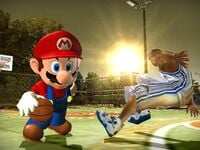
Mario, along with Luigi and Princess Peach, as a result of the Nintendo and EA partnership, makes a fully playable guest appearance exclusive to the Nintendo GameCube version of NBA Street V3. The three are part of a team entitled "Nintendo All-Stars," alongside other all-star basketball teams. Mario's team additionally has a special basketball court.
Dance Dance Revolution: Mario Mix
In Dance Dance Revolution: Mario Mix, Mario has to win in dance-offs to help save the Mushroom Kingdom from being controlled by the Music Keys. In the beginning, Waluigi goes to Truffle Towers to gain Music Keys and grant him the power to "hypnotize the rhythm-less masses." However, after he opens the door, all but one key fly to various locations in the Mushroom Kingdom. One of the Music Keys is found in the sea, another one in Wario's Carnival, and another in Freeze Mountain. Toad, who sees this occur, rushes to tell Mario (or Luigi). If all keys are not returned, they can be exploited by anyone.
Mario responds by setting out to find all four Music Keys, along with Toad. Using the SS Brass to navigate, Mario challenges the key owners to dance-offs. After Mario wins the keys, however, Bowser steals them. Mario performs the "Final Dance Off" with him and gets the Music Keys back. Bowser reveals his intentions of stealing the keys: to help cure his tone-deafness. Mario and Toad decide to use the keys to change Bowser's Castle and the surrounding area into a paradise. From this, though, some music has been implemented into their souls, so they cannot stop dancing. These keys then are all returned to Truffle Towers.
Mario Baseball series
Mario Superstar Baseball
In Mario Superstar Baseball, Mario is a balanced character, although his running is only average in the first game. Mario's special ball is the classic Fireball, which allows him to pitch or launch the ball at high speeds. Mario's abilities are very similar to Luigi's. His default team is called the Mario Sunshines in Mario Superstar Baseball, and mostly consists of the non-playable characters from Super Mario Sunshine.
Mario's special abilities include Wall Jump, which can help him catch fly balls at the edge of the field, and an improved Sliding Catch.
Mario Super Sluggers
In Mario Super Sluggers, Mario's team is called the Mario Fireballs, which consists of the Mario Bros., the baby Mario Bros., Piantas, Nokis, a Monty Mole, and a Blooper. Mario also had his batting and running skills improved, while his pitching and fielding remain the same. Mario's ability is Enlarge, which enables him to knock away third-base and home-base players and possibly the baseball if he succeeds a close play.
SSX on Tour
Mario, Luigi, and Peach, as with NBA Street V3, make another playable guest appearance in the Nintendo GameCube version of SSX on Tour, stemming from the same partnership with Nintendo and Electronic Arts. In SSX on Tour, Mario snowboards in a mountain and performs various stunts to earn points.
Super Princess Peach
Mario once again ends up in need of rescue during the events of Super Princess Peach. Bowser sends an army of Hammer Bros. (led by Army Hammer Bro) and Goombas to invade Peach's Castle. Mario, Luigi, and the Toads, busy defending the castle, are subdued by the power of the Vibe Scepter and captured by a group of Hammer Bros. Princess Peach is not in the castle at the time and so escapes the attack. Mario and the others are taken to Vibe Island, the source of the enemies' power, where they are held hostage and have no power to escape; Mario is imprisoned in a dungeon of Bowser's Villa. After reading a note left by Bowser about having captured Mario, Peach decides to go on a mission to rescue Mario herself. Before leaving for Vibe Island, Toadsworth hands her a magical umbrella named Perry. Peach and Perry venture through various parts of the island, defeating many of Bowser's minions and rescuing the Toads along the way. After rescuing Luigi, Peach and Perry finally arrive at Bowser's Villa, where Mario is being held. Following Bowser's defeat at the hands of Peach by use of emotional powers called Vibes, Peach and Perry reach Mario's dungeon cell. Perry uses his handle to unlock the cell and free Mario, who then shares a joyful reunion with Peach and gives her a bunch of flowers. Following a successful rescue mission, Peach, Perry, Mario, Luigi, and the Toads return to the Mushroom Kingdom.
Mario Hoops 3-on-3
In Mario Hoops 3-on-3, Mario is a default character. His Special Shot is the Fire Shot, which involves Mario dribbling the ball around him in the shape of an M and then either alley-ooping or dunking a flaming red basketball into the hoop. To execute this move, the player must tap the touchscreen in the shape of the letter M. Mario is classified as a balanced character.
Mario Strikers series
In the Mario Strikers (or Mario Football in the PAL regions) series, Mario takes on a variation of yet another sport, soccer (or football), referred to in Mario Strikers: Battle League as "Strike". His stats are all-around in all three games: Super Mario Strikers, Mario Strikers Charged, and Mario Strikers: Battle League. His Super Strike in Super Mario Strikers is the Fire Strike, while his Hyper Strike in Mario Strikers: Battle League is the Fire Cyclone. His Super Ability in Mario Strikers Charged is Super Mario! Unlike previous sports games, where Mario stayed in his usual traditional outfit, in the Mario Strikers series, he is seen wearing different gear, including different clothes and cleats. In the first two games, Mario's team number is 1 and his captain type is Balanced. However, in Battle League, he is an all-around character with an emphasis on technique.
Itadaki Street series
Itadaki Street DS
Mario appears as a default Rank A playable character in Itadaki Street DS.
Fortune Street
- “Here we go! Just remember, little die: Mario's your best friend!”
- —Mario, Fortune Street
Mario is a default character in Fortune Street, although he is playable only in the multiplayer mode, as all Mario and Dragon Quest characters are in the game. As an opponent, he is Rank A, sharing this rank with Bowser and Bowser Jr., making him the second-most difficult opponent to face. Also, as an opponent, he is able to speak in full sentences, a rare trait in the video games.
Mario & Sonic series
Mario & Sonic at the Olympic Games
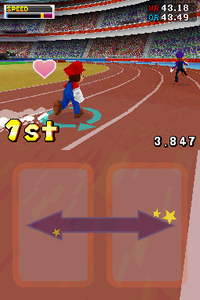
Mario first appears as a playable character in both the Wii version and Nintendo DS version Mario & Sonic at the Olympic Games, where he is an All-Around type character, giving him balanced statistics in all categories. He appears in the opening of the Wii version at the start with all of the other athletes, as well as in the 100m.
Mario & Sonic at the Olympic Winter Games
Mario returns as a playable character in both versions of Mario & Sonic at the Olympic Winter Games. In the Wii version, Mario appears in the opening with all of the other athletes at the start and end, as well as competing in Snowboard Cross. The game also features an outfit based on Mario for Miis to wear, as well as ones based on Bee Mario and Fire Mario. In the Nintendo DS version, Mario can also be used as one of the playable characters to explore Winter Island and Dream Island in Adventure Tours mode, as well as being one of the first two to be selectable in events, along with Sonic.
Mario & Sonic at the London 2012 Olympic Games
Mario returns as an All-Around type character in the Wii version of Mario & Sonic at the London 2012 Olympic Games, appearing in the opening with the other athletes at the beginning, competing in Trampoline, Dream Hurdles and Dream Uneven Bars, and with Sonic on top of Big Ben. The Mii outfits return from the Wii version of Mario & Sonic at the Olympic Winter Games, as well as the addition of two based on Propeller Mario and Penguin Mario.
In the Nintendo 3DS version of the game, Mario is included in the Heroes group, alongside Sonic, Luigi, and Tails, which allows him to only compete in certain Events. In the Story Mode, Mario first appears in Stadium Blues, where he and Luigi defeat a pair of imposters, and later find and destroy a fog machine, clearing up the Main Stadium. Mario and Luigi head to Hyde Park with Toad to check that Peach and the others staying there are alright, before moving on to the British Museum, where they meet up with Sonic and Tails to clear the fog from there. After finding out some information about the source of the fog, the group splits up, and Mario and Toad find Wario challenging Dr. Eggman, who they later follow to see destroying another fog machine. They make their way back to the Main Stadium to meet up with the others, and Mario helps save Cream from the imposters when the Phantasmal Fog returns, before heading to Stonehenge to try to find the lid of the Fog urn. The group return to London after finding out that Bowser and Dr. Eggman are hiding inside Big Ben, and after defeating more imposters, Mario, Luigi, Sonic and Tails head there to confront them. When they arrive, they find that Bowser and Dr. Eggman have been powered up by the Phantasmal Fog, but Mario and Sonic defeat them and seal the fog back into the urn. The group then all head back to the Main Stadium for the opening ceremony of the Olympic games. A badge of Mario can also be obtained from the badge machine.
Mario & Sonic at the Sochi 2014 Olympic Winter Games
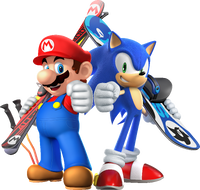
Mario reappears in Mario & Sonic at the Sochi 2014 Olympic Winter Games, once again as a playable All-Around type character. All of the Mii costumes based on Mario from the Wii version of Mario & Sonic at the London 2012 Olympic Games return as well.
Mario & Sonic at the Rio 2016 Olympic Games
Mario reappears in the Wii U version of Mario & Sonic at the Rio 2016 Olympic Games once again as an All-Around type character. The Mario outfits return from the previous two instalments, but now must be collected in separate head and body parts which each have their own set of bonus statistics. In the Nintendo 3DS version, he, Sonic and the Mii are the only characters that can be used for all events. In the Road to Rio mode, Mario's disappearance causes a disagreement between his and Sonic's gyms, though it is later revealed that Mario was missing due to investigating the theft of his and Sonic's Olympic medals from a museum.
Mario is playable as a Balance character in all events in Mario & Sonic at the Rio 2016 Olympic Games Arcade Edition, but has recommended events of 100m and Long Jump. Here, all of his statistics are above average.
Mario & Sonic at the Olympic Games Tokyo 2020
Mario reappears in Mario & Sonic at the Olympic Games Tokyo 2020 once again as an All-Around type playable character, now wearing appropriate sporting clothing depending on the event. In addition to being playable in the Tokyo 2020 events, Mario is also among the eight characters playable in the Tokyo 1964 events. In the story mode, he, Sonic, Bowser, Dr. Eggman, and Toad get sucked into a game system featuring 8-bit graphics and are transported back in time to the Tokyo 1964 Olympic Games. While in the game system, Mario uses his 8-bit appearance first used in Super Mario Bros.. To return to the real world, the five characters need to win gold medals in Olympic events.
Mario is also an All-Around type playable character in Mario & Sonic at the Olympic Games Tokyo 2020 - Arcade Edition, having the same statistics as the arcade version of the previous installment.
Mario Sports Mix
Mario is an All-Rounder type character in Mario Sports Mix and all of his stats are average. His stadium in the game is Mario Stadium. Most of his attacks involve spinning. In Basketball, he spins into his opponent if he is blocking his opponent for too long. In Hockey, his hits involve a two-hit combo followed by a spin. In Dodgeball, he rolls forward to avoid any incoming hit. In Volleyball, he spins when he spikes. In all sports, his special move is a fire blast that is so powerful that opponents have to resist the force while sliding backwards if they do not want Mario to score.
Captain Toad: Treasure Tracker
In Captain Toad: Treasure Tracker, Mario makes a brief cameo at the fiftieth and final room of Mummy-Me Maze Forever on a poster. Tapping the poster gives a single coin. In the Wii U version of the game, he also appears in the post-credits cutscene, which is the same as the cutscene shown at the beginning of Super Mario 3D World.
Puzzle & Dragons: Super Mario Bros. Edition
The story in Puzzle & Dragons: Super Mario Bros. Edition is similar to ones in the more traditional Mario platformers. Princess Peach invites Mario to her castle to show him some bright Orbs that have appeared. When Mario arrives, however, Bowser abducts Peach and Kamek steals the power of these Orbs, causing more Orbs to scatter in the Mushroom Kingdom. Mario and Red Toad set out to rescue Peach by using these Orbs to attack enemies along the way. In the meantime, Mario can recruit enemies from Baddie Blocks and allies, such as Yoshis, that have been captured by Bowser. At Bowser's Castle, Mario defeats Bowser Jr. and Kamek several times. When Mario reaches and defeats Bowser, Bowser uses the Koopalings and Bowser Jr. together to attempt to beat Mario but fails. Mario eventually rescues Peach.
Mario is among the first usable team members in Puzzle & Dragons: Super Mario Bros. Edition, and either he, Luigi, or the duo's power-up forms (including Small Mario, Super Mario, Ice Mario, Raccoon Mario, Fire Mario, Boo Mario, Penguin Mario, Flying Squirrel Mario, Bee Mario, Statue Mario, Cat Mario, and White Tanooki Mario) can serve as leaders of the team. All of Mario and his various forms have the fire attribute in common.
The Cat Mario Show
The Cat Mario Show is a video series depicting Mario and Princess Peach (in their Cat power-ups from Super Mario 3D World). The two present general information on upcoming games for the Nintendo 3DS, the Wii U, and the Switch; show tips and tricks on particular games; and quiz viewers.
Mario Sports Superstars
Mario appears in Mario Sports Superstars, where he is a Balance type character in most sports; in tennis, he is classified as the similar All-Around type. As a result, Mario has few weak stats, but by the same token he does not excel in any stat in particular. His special shots involve hitting the ball with a fiery streak. In golf, Mario's default drive is 220 yards and his shots travel straight and high.
Mario + Rabbids series
Mario + Rabbids Kingdom Battle
- See also: Rabbid Mario
In Mario + Rabbids Kingdom Battle, Mario and his friends encounter a Mushroom Kingdom that has been fused with the world of Rabbids. Mario saves Beep-0 and later meets Rabbid Luigi and Rabbid Peach, two Rabbids based on Luigi and Peach. He also reunites with Luigi, Yoshi, Toad, and Princess Peach to help restore order to Mushroom Kingdom. They use weapons attached to a message from an unknown individual named "F.B." (later revealed to be Beep-0 from the future).
Gameplay-wise, Mario is required in battle. He is a medium-range fighter with good mobility, and he has the highest offense tied with Yoshi. His special Jump is the Stomp Jump, where he lands on an enemy to deal 30 points of damage and lands on a nearby cell. His primary weapon is the Lightning Shark, which fires one missile at a time, while his secondary one is the Button Masher, which hits multiple targets at once. These weapons can be powered up by M-Power, which increases Mario's weapon damage along with the damage caused by his allies. His primary technique is Hero Sight, which allows him to immediately damage the first enemy he sees that moves.
In the Donkey Kong Adventure DLC, Mario's role is restricted as a minor supporting character. He is instead seen with Rabbid Luigi and Luigi trying to warn Rabbid Peach who is trying to charge her phone to get away from the Time Washing Machine, but are too late.
Additionally, in the beginning of the game, the Genius Girl is shown to own a Mario figurine.
Mario + Rabbids Sparks of Hope
Mario reappears in Mario + Rabbids Sparks of Hope. At the beginning of the game, Rabbid Peach is abducted by the Darkmess Manta, and Mario enters the Darkmess Dimension via the Manta to save her. After Mario and Rabbid Peach defeat several Stooges and Goombas, they are rescued by the rest of the team in the WM ARC speceship. Mario and Rabbid Peach join the rest of the team to stop the evil force Cursa from consuming the Sparks to save the universe.
Mario now wields the Dual Slingers,[7] a dual-wielding blaster-like weapon that can fire at two enemies at once. His Hero Sight technique returns from the previous game. His Stomp ability also returns. If unlocked in the skill tree, he can even fire at enemies during a team jump.[8] Unlike in Mario + Rabbids Kingdom Battle, Mario is not required to be in the party at all times.
The Super Mario Bros. Movie
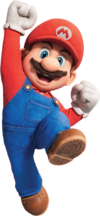
Mario appears as the titular protagonist in The Super Mario Bros. Movie. In the English version of the movie, he is voiced by Chris Pratt.
The film's plot revolves around Mario's attempt to rescue his brother from Bowser after they get separated in a warp zone. Unlike in the video games, Mario and Luigi are based in Brooklyn and Queens, living with their family, and run a new start-up business, Super Mario Bros. Plumbing. They formerly worked under Spike, who is seen antagonizing the brothers. His father also derides his son for "[quitting] a steady job for some crazy dream", to Mario's dismay. He and Luigi then go underground to fix a water main, only for Mario to accidentally visit the Mushroom Kingdom after discovering a Warp Pipe in an abandoned part of the sewers. After they are separated, Mario meets Toad in Mushroom Kingdom, who introduces himself and helps guide Mario to Princess Peach. After learning that Bowser has captured Luigi, Mario and Toad later join Princess Peach to assist her in defeating Bowser, who wishes to take over the world, but also wants to marry Princess Peach.
Mario's design, first teased in Template:Media link in September 2022 and revealed fully in the movie's teaser trailer, retains his general proportions but differs from the games slightly. He has slightly smaller hands, mustache, nose, and overall buttons; a more visible neck; rounder eyes and cap; a different shirt with buttons and a longer collar; scaled down hair features; more detail on his teeth and hair; and a detailed pocket on the front of his overalls.
Mario's voice actors in foreign dubs of the film include the following:
- Motaz El Shazli (Arabic)
- Rosen Rusev (Bulgarian)
- Tyson Chak (Hong Kong Cantonese)
- Ivan Labanda (Catalan)
- Tin Rožman (Croatian)
- Martin Písařík (Czech)
- Pilou Asbæk (Danish)
- Florus van Rooijen (Dutch)
- Lander Severins (Flemish Dutch)
- Priit Võigemast (Estonian)
- Riku Nieminen (Finnish)
- Philippe Martin (Canadian French)
- Pierre Tessier (European French)
- Leonhard Mahlich (German)
- Konstantínos Lágos (Greek)
- Ido Mosseri (Hebrew)
- Shanoor Mirza (Hindi)
- János Szemenyei (Hungarian)
- Claudio Santamaria (Italian)
- Mamoru Miyano (Japanese)
- Hwang Chang-yeong (Korean)
- Vaidotas Baumila (Lithuanian)
- Zhao Yi (Chinese Mandarin)
- Zhang Teng (Taiwanese Mandarin)
- Christopher Robin Omdahl (Norwegian)
- Kamil Pruban (Polish)
- Raphael Rossatto (Brazilian Portuguese)
- Luís Barros (European Portuguese)
- Alexander Naparin (Russian)
- Đorđe Stojković (Serbian)
- Michal Hallon (Slovak)
- Mirko Medved (Slovenian)
- Guillermo Romero (European Spanish)
- Raúl Anaya (Latin American Spanish)
- Oscar Harryson (Swedish)
- Phubet Patpreecha (Thai)
- İlham Erdoğan (Turkish)
- Volodymyr Ostapchuk (Ukrainian)
- Anh Luân (Vietnamese)
Other appearances
- See also: Merchandise, Toys, Publications, Lists of Mario references
Mario has made several small appearances outside of his own series, including other Nintendo series. In Tennis and Punch-Out!! for the NES, Mario is the referee for tennis and boxing matches, respectively. In the NES version of Tetris, Mario, alongside Luigi and Princess Toadstool, makes a cameo in Game B upon completing one of the heights, specifically height 5. He and Luigi are seen doing the hopak.
In the Game Boy version of Qix, Mario appears in a scene after completing the game. Depending on how many points have been earned, Mario can appear in various locations around the world, taking a role that is stereotypically associated with each region.
In the SNES version of SimCity, the player is awarded a statue of Mario if their city has a population of 500,000 residents.
In Stunt Race FX, billboards of Mario's head can be seen along various courses.
Mario appears in the LazerBlazer game in Super Scope 6, in the Type A: Intercept mode. Mario pilots a plane as he is chased by Lemmy Koopa on a rocket.
Mario, voiced by Charles Martinet, is heard narrating Pac-Man Vs.
Mario is featured in the built-in AR Games application for the Nintendo 3DS, as a Character Card, a traceable image, and a stamp.
Mario's head, nose, and moustache can be used as stamps for photos in the Game Boy Camera peripheral. The stamp of Mario's face can also be seen dancing on the title screen.
The Super Mario Mash-up in Minecraft features a playable Mario in the style of the game.[9] It also features Mario's other forms as playable characters, including Dr. Mario, Tanooki Mario, Propeller Mario, Fire Mario, Mario with F.L.U.D.D., Boomerang Mario, and Cat Mario.
The "Factory Entrance" concept artwork from Donkey Kong Country Returns features a hidden 8-bit sprite of Mario's appearance in Donkey Kong, made out of various parts on the right side of the machinery.
Mario has several merchandising lines ranging from a Japanese plush series by San-ei to a 2014 series of articulate action figures by Bandai Tamashii Nations SH Figuarts. Mario is also featured in a few food packaging, including Campbell's and gummies. Mario has a neon sign that depicts him. Mario T-shirts, toys, and alike have also been produced, and McDonald's released a chain of toys based on the popular Mario video game Super Mario Bros. 3, as seen here.
Mario is also featured in several tabletop games that promote Nintendo, including Nintendo Monopoly, where he costs $400, replacing the Boardwalk, the most expensive space in the game. On the ? Block and Coin Block (later Block) cards, he replaces Mr. Monopoly. He is also one of the four base characters in the Standard Edition (five in the Collector's Edition) of Monopoly Gamer. Mario is also featured in Super Mario branded games, including but not limited to Super Mario Chess (as the king) and Super Mario Checkers & Tic Tac Toe.
References
- ^ Porges, Seth (October 19, 2009). Exclusive Interview With Nintendo Gaming Mastermind Shigeru Miyamoto. Popular Mechanics. Retrieved November 25, 2009.
- ^ Snider, Mike (November 08, 2010). Q&A: 'Mario' creator Shigeru Miyamoto. USA Today. Retrieved March 25, 2016.
- ^ "Mario the carpenter and his brother Luigi are hopping mad! The water pipes in their house are blocked with crawling creatures. If the two brothers can’t get rid of them they’ll never take a bath again!" - Mario Bros. Atari game manual, first page.
- ^ Nintendo. (January 13, 2017). Super Mario Odyssey - Nintendo Switch Presentation 2017 Trailer. YouTube. Retrieved January 13, 2017.
- ^ Mario Kart Tour (United States). apple.com. Retrieved November 12, 2022. (Archived November 8, 2022, 15:58:48 UTC via Wayback Machine.) "Float through the 3DS Rainbow Road track in the Space Tour, fly through the GBA Sky Tour[sic] as Aviator Mario…who knows what’s coming next?"
- ^ An alternate box art of Mario is Missing! sported the "Mario Discovery Series" symbol.
- ^ https://www.nintendo.com/store/products/mario-plus-rabbids-sparks-of-hope-gold-edition-switch/
- ^ https://www.ubisoft.com/en-us/game/mario-rabbids/sparks-of-hope/news-updates/54KqtyUg25UlrGQ20LC0ga/mario-rabbids-sparks-of-hope-a-deep-dive-into-combat-and-hero-archetypes
- ^ Nintendo. (May 9, 2016) Super Mario Mash-Up Pack for Minecraft - Wii U Edition. YouTube. Retrieved June 10, 2016.
